Managing Budget and Financial Plans for Big Red Bicycle Pty Ltd
VerifiedAdded on 2023/06/13
|22
|5227
|178
AI Summary
This assignment analyzes the master budget prepared by the management of Big Red Bicycle Pty Ltd and formulates a contingency plan to counter the risks faced by the business. The budget analysis identifies discrepancies and areas that are not achievable for the business. The contingency plan includes strategies to minimize risks and explores new markets in overseas for business. The report also includes a variance report for the year 2011/2012.
Contribute Materials
Your contribution can guide someone’s learning journey. Share your
documents today.
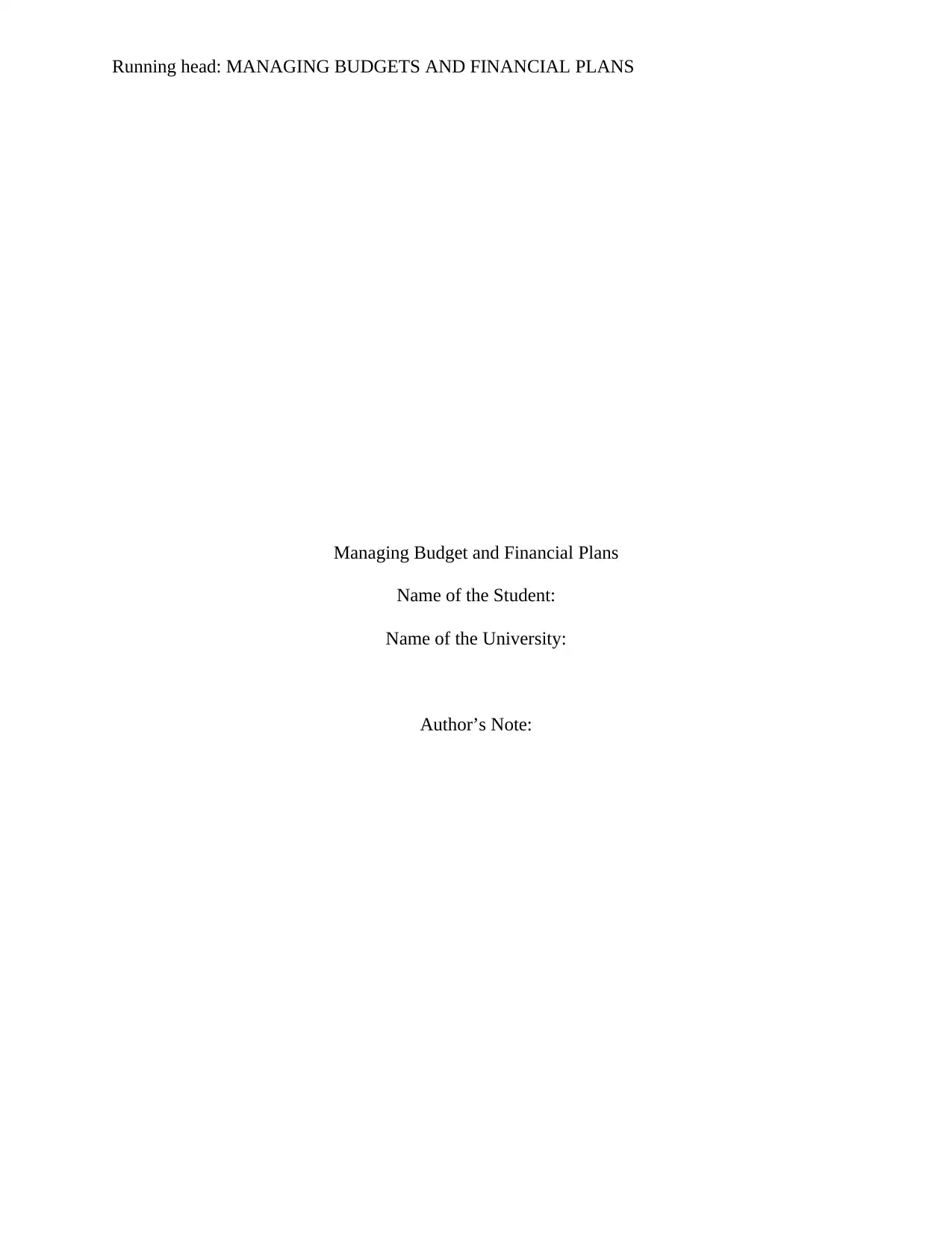
Running head: MANAGING BUDGETS AND FINANCIAL PLANS
Managing Budget and Financial Plans
Name of the Student:
Name of the University:
Author’s Note:
Managing Budget and Financial Plans
Name of the Student:
Name of the University:
Author’s Note:
Secure Best Marks with AI Grader
Need help grading? Try our AI Grader for instant feedback on your assignments.
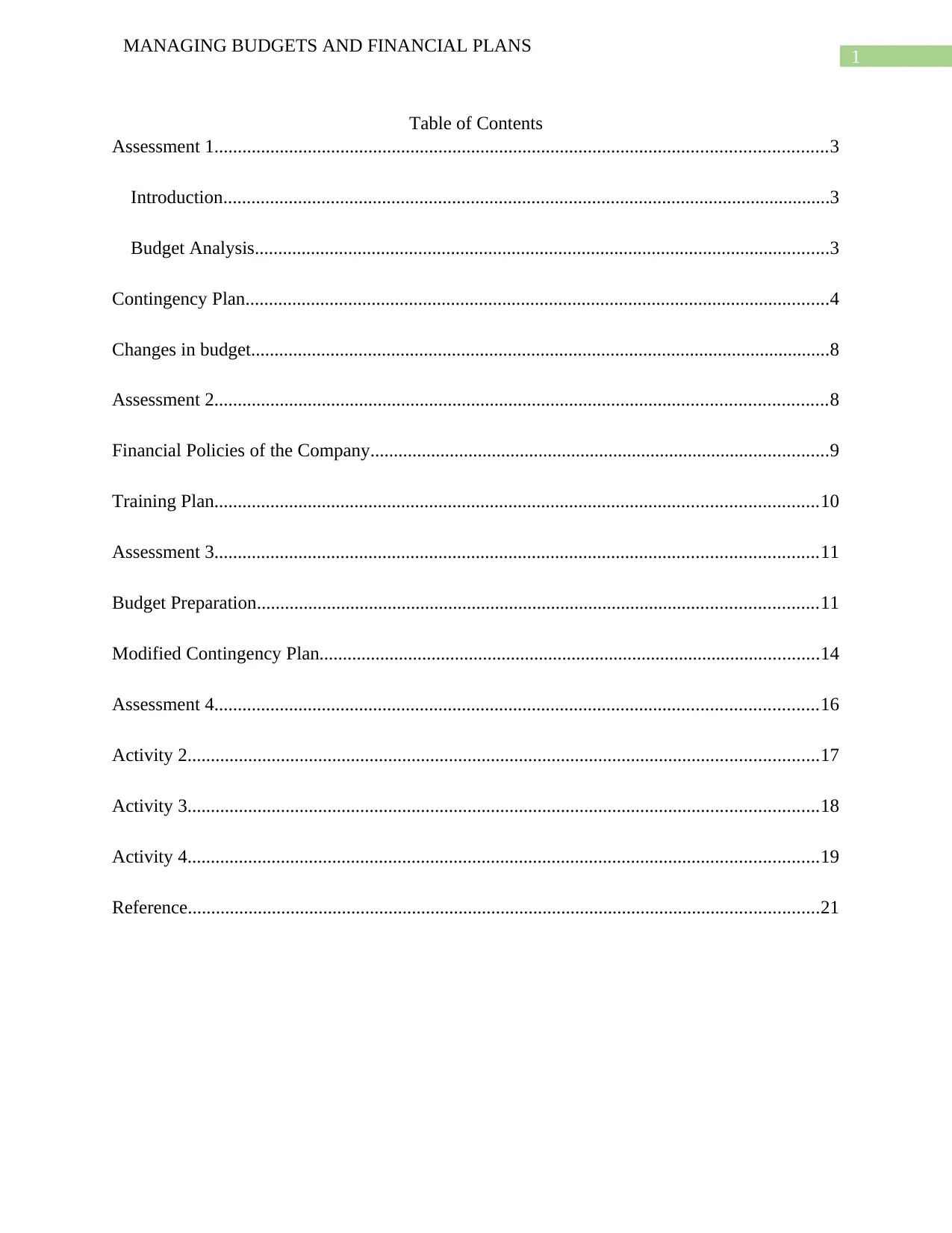
1
MANAGING BUDGETS AND FINANCIAL PLANS
Table of Contents
Assessment 1...................................................................................................................................3
Introduction..................................................................................................................................3
Budget Analysis...........................................................................................................................3
Contingency Plan.............................................................................................................................4
Changes in budget............................................................................................................................8
Assessment 2...................................................................................................................................8
Financial Policies of the Company..................................................................................................9
Training Plan.................................................................................................................................10
Assessment 3.................................................................................................................................11
Budget Preparation........................................................................................................................11
Modified Contingency Plan...........................................................................................................14
Assessment 4.................................................................................................................................16
Activity 2.......................................................................................................................................17
Activity 3.......................................................................................................................................18
Activity 4.......................................................................................................................................19
Reference.......................................................................................................................................21
MANAGING BUDGETS AND FINANCIAL PLANS
Table of Contents
Assessment 1...................................................................................................................................3
Introduction..................................................................................................................................3
Budget Analysis...........................................................................................................................3
Contingency Plan.............................................................................................................................4
Changes in budget............................................................................................................................8
Assessment 2...................................................................................................................................8
Financial Policies of the Company..................................................................................................9
Training Plan.................................................................................................................................10
Assessment 3.................................................................................................................................11
Budget Preparation........................................................................................................................11
Modified Contingency Plan...........................................................................................................14
Assessment 4.................................................................................................................................16
Activity 2.......................................................................................................................................17
Activity 3.......................................................................................................................................18
Activity 4.......................................................................................................................................19
Reference.......................................................................................................................................21
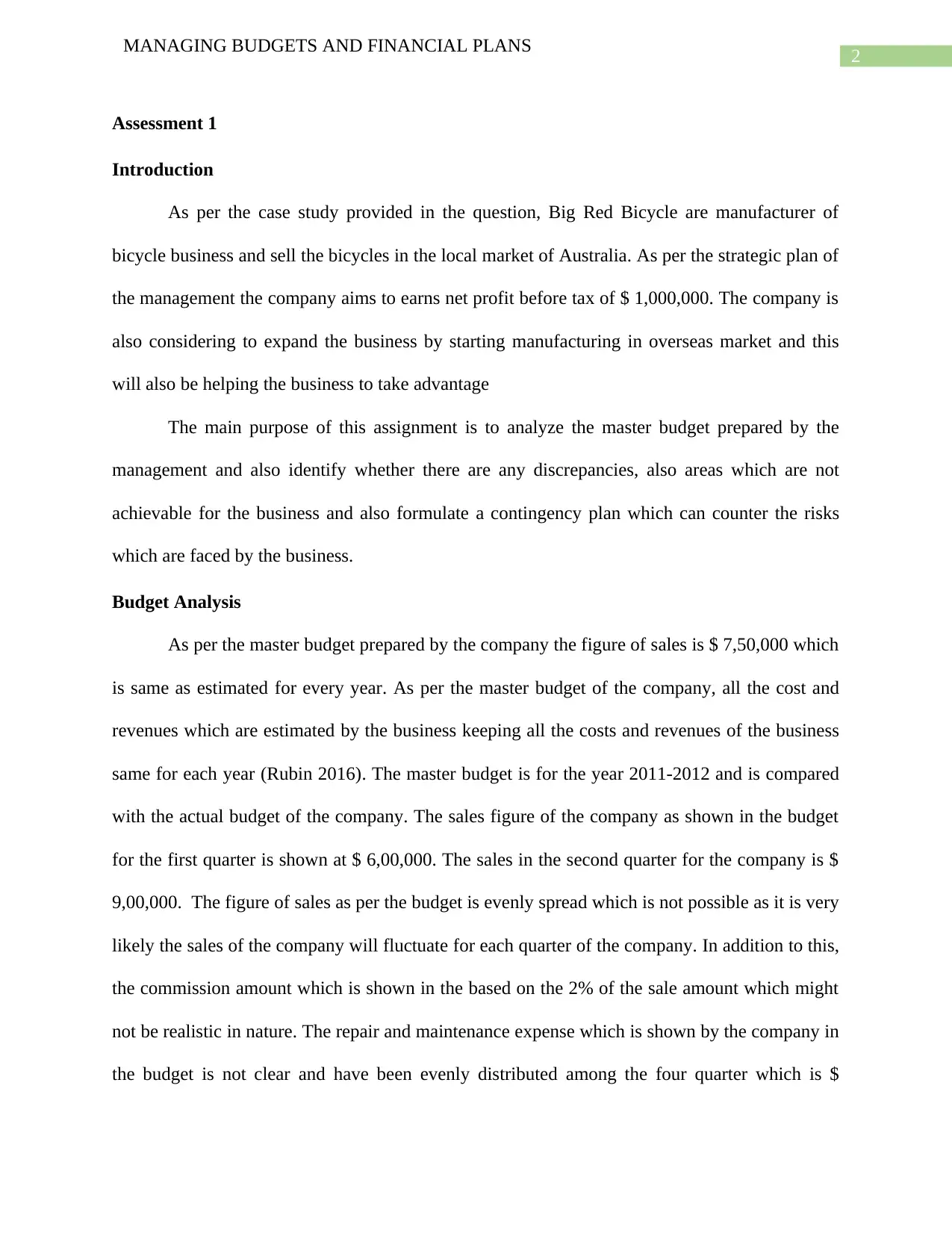
2
MANAGING BUDGETS AND FINANCIAL PLANS
Assessment 1
Introduction
As per the case study provided in the question, Big Red Bicycle are manufacturer of
bicycle business and sell the bicycles in the local market of Australia. As per the strategic plan of
the management the company aims to earns net profit before tax of $ 1,000,000. The company is
also considering to expand the business by starting manufacturing in overseas market and this
will also be helping the business to take advantage
The main purpose of this assignment is to analyze the master budget prepared by the
management and also identify whether there are any discrepancies, also areas which are not
achievable for the business and also formulate a contingency plan which can counter the risks
which are faced by the business.
Budget Analysis
As per the master budget prepared by the company the figure of sales is $ 7,50,000 which
is same as estimated for every year. As per the master budget of the company, all the cost and
revenues which are estimated by the business keeping all the costs and revenues of the business
same for each year (Rubin 2016). The master budget is for the year 2011-2012 and is compared
with the actual budget of the company. The sales figure of the company as shown in the budget
for the first quarter is shown at $ 6,00,000. The sales in the second quarter for the company is $
9,00,000. The figure of sales as per the budget is evenly spread which is not possible as it is very
likely the sales of the company will fluctuate for each quarter of the company. In addition to this,
the commission amount which is shown in the based on the 2% of the sale amount which might
not be realistic in nature. The repair and maintenance expense which is shown by the company in
the budget is not clear and have been evenly distributed among the four quarter which is $
MANAGING BUDGETS AND FINANCIAL PLANS
Assessment 1
Introduction
As per the case study provided in the question, Big Red Bicycle are manufacturer of
bicycle business and sell the bicycles in the local market of Australia. As per the strategic plan of
the management the company aims to earns net profit before tax of $ 1,000,000. The company is
also considering to expand the business by starting manufacturing in overseas market and this
will also be helping the business to take advantage
The main purpose of this assignment is to analyze the master budget prepared by the
management and also identify whether there are any discrepancies, also areas which are not
achievable for the business and also formulate a contingency plan which can counter the risks
which are faced by the business.
Budget Analysis
As per the master budget prepared by the company the figure of sales is $ 7,50,000 which
is same as estimated for every year. As per the master budget of the company, all the cost and
revenues which are estimated by the business keeping all the costs and revenues of the business
same for each year (Rubin 2016). The master budget is for the year 2011-2012 and is compared
with the actual budget of the company. The sales figure of the company as shown in the budget
for the first quarter is shown at $ 6,00,000. The sales in the second quarter for the company is $
9,00,000. The figure of sales as per the budget is evenly spread which is not possible as it is very
likely the sales of the company will fluctuate for each quarter of the company. In addition to this,
the commission amount which is shown in the based on the 2% of the sale amount which might
not be realistic in nature. The repair and maintenance expense which is shown by the company in
the budget is not clear and have been evenly distributed among the four quarter which is $
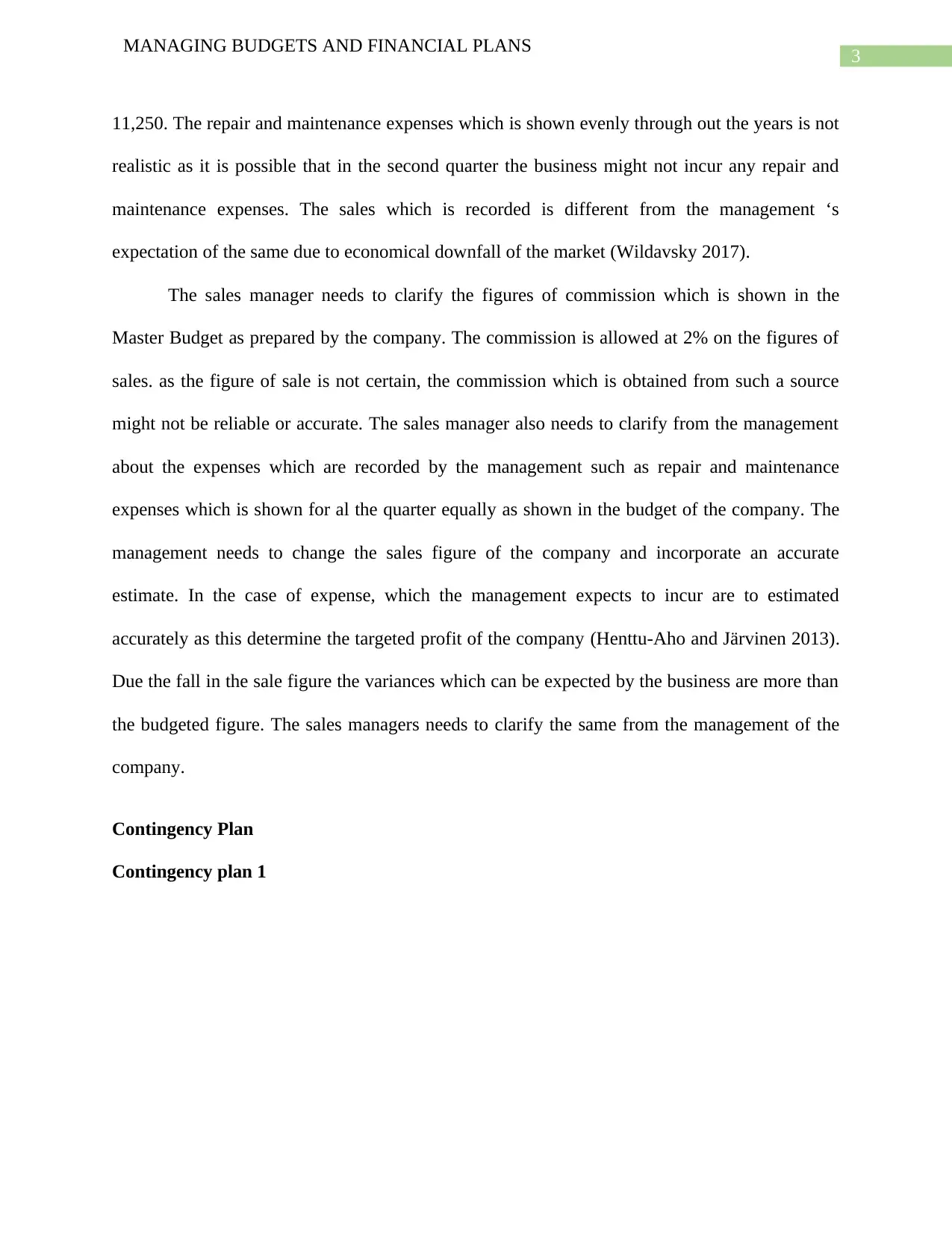
3
MANAGING BUDGETS AND FINANCIAL PLANS
11,250. The repair and maintenance expenses which is shown evenly through out the years is not
realistic as it is possible that in the second quarter the business might not incur any repair and
maintenance expenses. The sales which is recorded is different from the management ‘s
expectation of the same due to economical downfall of the market (Wildavsky 2017).
The sales manager needs to clarify the figures of commission which is shown in the
Master Budget as prepared by the company. The commission is allowed at 2% on the figures of
sales. as the figure of sale is not certain, the commission which is obtained from such a source
might not be reliable or accurate. The sales manager also needs to clarify from the management
about the expenses which are recorded by the management such as repair and maintenance
expenses which is shown for al the quarter equally as shown in the budget of the company. The
management needs to change the sales figure of the company and incorporate an accurate
estimate. In the case of expense, which the management expects to incur are to estimated
accurately as this determine the targeted profit of the company (Henttu-Aho and Järvinen 2013).
Due the fall in the sale figure the variances which can be expected by the business are more than
the budgeted figure. The sales managers needs to clarify the same from the management of the
company.
Contingency Plan
Contingency plan 1
MANAGING BUDGETS AND FINANCIAL PLANS
11,250. The repair and maintenance expenses which is shown evenly through out the years is not
realistic as it is possible that in the second quarter the business might not incur any repair and
maintenance expenses. The sales which is recorded is different from the management ‘s
expectation of the same due to economical downfall of the market (Wildavsky 2017).
The sales manager needs to clarify the figures of commission which is shown in the
Master Budget as prepared by the company. The commission is allowed at 2% on the figures of
sales. as the figure of sale is not certain, the commission which is obtained from such a source
might not be reliable or accurate. The sales manager also needs to clarify from the management
about the expenses which are recorded by the management such as repair and maintenance
expenses which is shown for al the quarter equally as shown in the budget of the company. The
management needs to change the sales figure of the company and incorporate an accurate
estimate. In the case of expense, which the management expects to incur are to estimated
accurately as this determine the targeted profit of the company (Henttu-Aho and Järvinen 2013).
Due the fall in the sale figure the variances which can be expected by the business are more than
the budgeted figure. The sales managers needs to clarify the same from the management of the
company.
Contingency Plan
Contingency plan 1
Secure Best Marks with AI Grader
Need help grading? Try our AI Grader for instant feedback on your assignments.
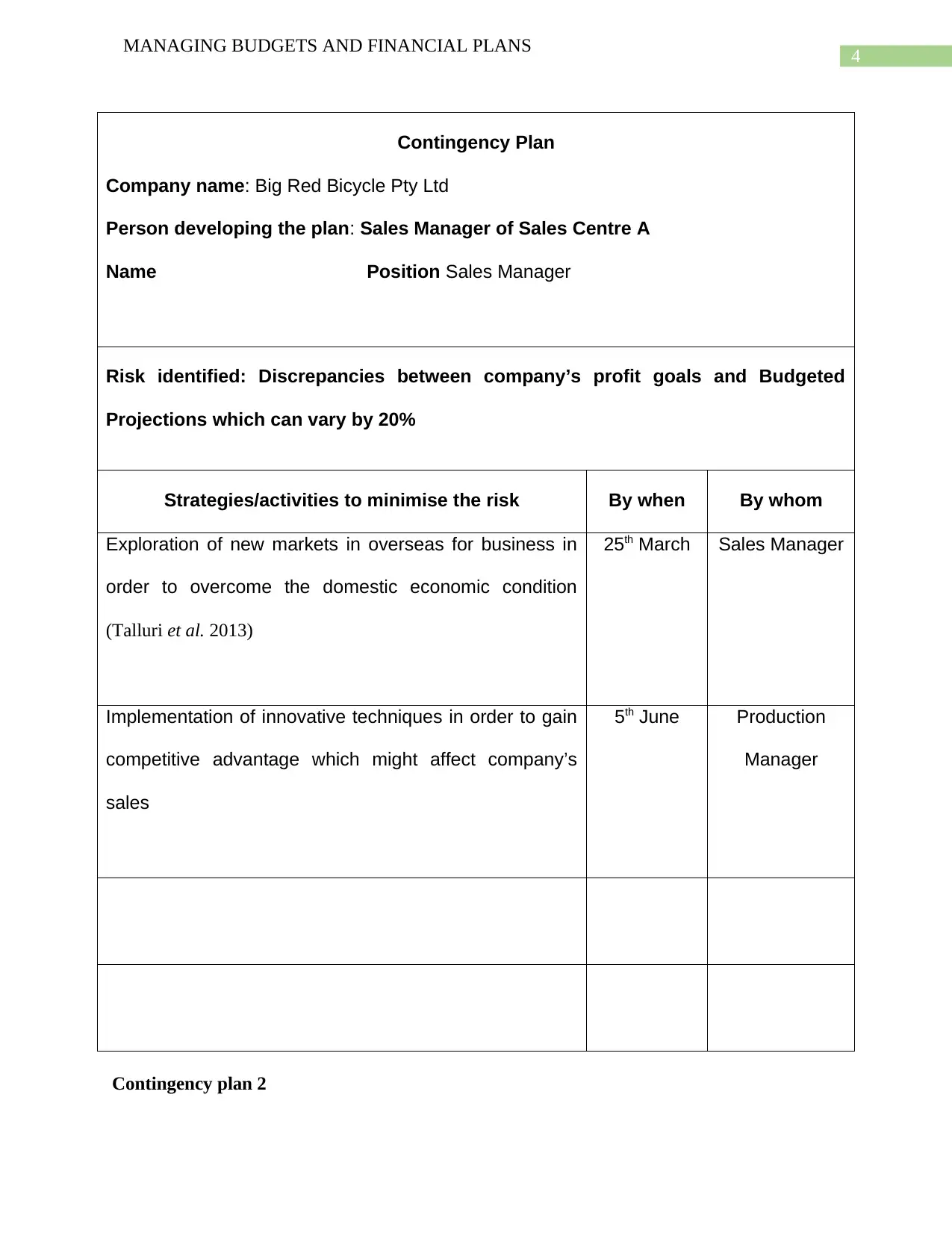
4
MANAGING BUDGETS AND FINANCIAL PLANS
Contingency Plan
Company name: Big Red Bicycle Pty Ltd
Person developing the plan: Sales Manager of Sales Centre A
Name Position Sales Manager
Risk identified: Discrepancies between company’s profit goals and Budgeted
Projections which can vary by 20%
Strategies/activities to minimise the risk By when By whom
Exploration of new markets in overseas for business in
order to overcome the domestic economic condition
(Talluri et al. 2013)
25th March Sales Manager
Implementation of innovative techniques in order to gain
competitive advantage which might affect company’s
sales
5th June Production
Manager
Contingency plan 2
MANAGING BUDGETS AND FINANCIAL PLANS
Contingency Plan
Company name: Big Red Bicycle Pty Ltd
Person developing the plan: Sales Manager of Sales Centre A
Name Position Sales Manager
Risk identified: Discrepancies between company’s profit goals and Budgeted
Projections which can vary by 20%
Strategies/activities to minimise the risk By when By whom
Exploration of new markets in overseas for business in
order to overcome the domestic economic condition
(Talluri et al. 2013)
25th March Sales Manager
Implementation of innovative techniques in order to gain
competitive advantage which might affect company’s
sales
5th June Production
Manager
Contingency plan 2
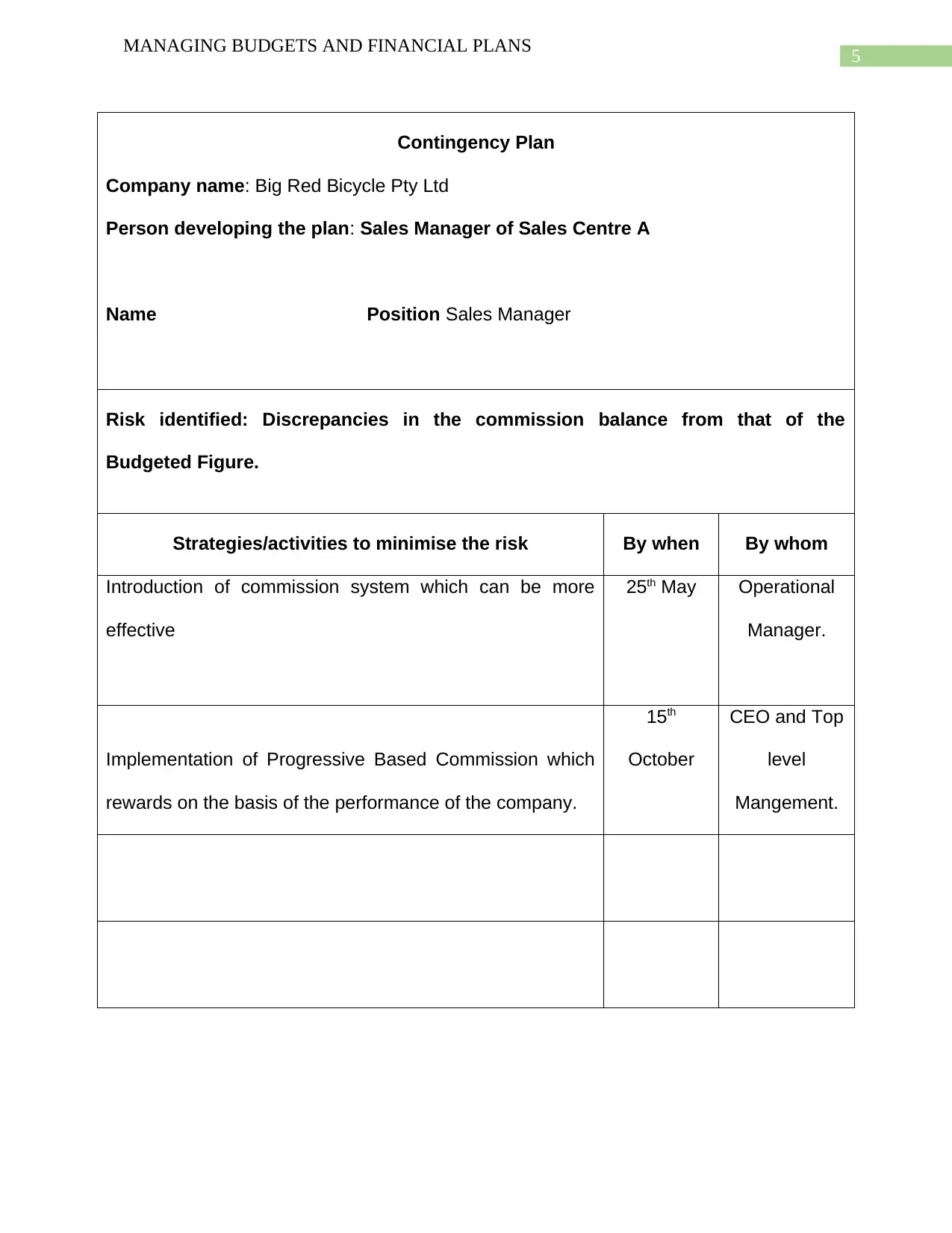
5
MANAGING BUDGETS AND FINANCIAL PLANS
Contingency Plan
Company name: Big Red Bicycle Pty Ltd
Person developing the plan: Sales Manager of Sales Centre A
Name Position Sales Manager
Risk identified: Discrepancies in the commission balance from that of the
Budgeted Figure.
Strategies/activities to minimise the risk By when By whom
Introduction of commission system which can be more
effective
25th May Operational
Manager.
Implementation of Progressive Based Commission which
rewards on the basis of the performance of the company.
15th
October
CEO and Top
level
Mangement.
MANAGING BUDGETS AND FINANCIAL PLANS
Contingency Plan
Company name: Big Red Bicycle Pty Ltd
Person developing the plan: Sales Manager of Sales Centre A
Name Position Sales Manager
Risk identified: Discrepancies in the commission balance from that of the
Budgeted Figure.
Strategies/activities to minimise the risk By when By whom
Introduction of commission system which can be more
effective
25th May Operational
Manager.
Implementation of Progressive Based Commission which
rewards on the basis of the performance of the company.
15th
October
CEO and Top
level
Mangement.
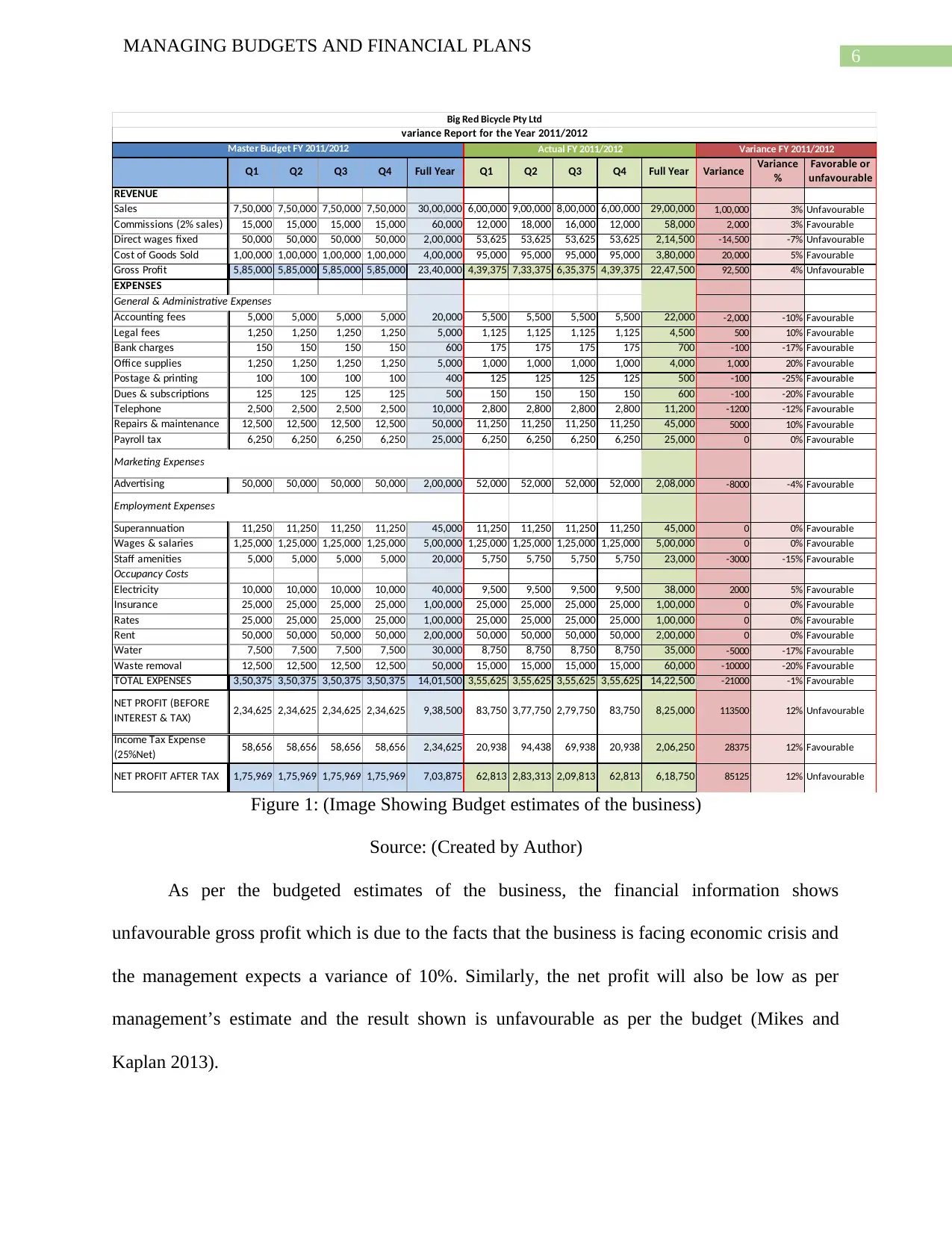
6
MANAGING BUDGETS AND FINANCIAL PLANS
Q1 Q2 Q3 Q4 Full Year Q1 Q2 Q3 Q4 Full Year Variance Variance
%
Favorable or
unfavourable
7,50,000 7,50,000 7,50,000 7,50,000 30,00,000 6,00,000 9,00,000 8,00,000 6,00,000 29,00,000 1,00,000 3% Unfavourable
15,000 15,000 15,000 15,000 60,000 12,000 18,000 16,000 12,000 58,000 2,000 3% Favourable
50,000 50,000 50,000 50,000 2,00,000 53,625 53,625 53,625 53,625 2,14,500 -14,500 -7% Unfavourable
1,00,000 1,00,000 1,00,000 1,00,000 4,00,000 95,000 95,000 95,000 95,000 3,80,000 20,000 5% Favourable
5,85,000 5,85,000 5,85,000 5,85,000 23,40,000 4,39,375 7,33,375 6,35,375 4,39,375 22,47,500 92,500 4% Unfavourable
5,000 5,000 5,000 5,000 20,000 5,500 5,500 5,500 5,500 22,000 -2,000 -10% Favourable
1,250 1,250 1,250 1,250 5,000 1,125 1,125 1,125 1,125 4,500 500 10% Favourable
150 150 150 150 600 175 175 175 175 700 -100 -17% Favourable
1,250 1,250 1,250 1,250 5,000 1,000 1,000 1,000 1,000 4,000 1,000 20% Favourable
100 100 100 100 400 125 125 125 125 500 -100 -25% Favourable
125 125 125 125 500 150 150 150 150 600 -100 -20% Favourable
2,500 2,500 2,500 2,500 10,000 2,800 2,800 2,800 2,800 11,200 -1200 -12% Favourable
12,500 12,500 12,500 12,500 50,000 11,250 11,250 11,250 11,250 45,000 5000 10% Favourable
6,250 6,250 6,250 6,250 25,000 6,250 6,250 6,250 6,250 25,000 0 0% Favourable
50,000 50,000 50,000 50,000 2,00,000 52,000 52,000 52,000 52,000 2,08,000 -8000 -4% Favourable
11,250 11,250 11,250 11,250 45,000 11,250 11,250 11,250 11,250 45,000 0 0% Favourable
1,25,000 1,25,000 1,25,000 1,25,000 5,00,000 1,25,000 1,25,000 1,25,000 1,25,000 5,00,000 0 0% Favourable
5,000 5,000 5,000 5,000 20,000 5,750 5,750 5,750 5,750 23,000 -3000 -15% Favourable
10,000 10,000 10,000 10,000 40,000 9,500 9,500 9,500 9,500 38,000 2000 5% Favourable
25,000 25,000 25,000 25,000 1,00,000 25,000 25,000 25,000 25,000 1,00,000 0 0% Favourable
25,000 25,000 25,000 25,000 1,00,000 25,000 25,000 25,000 25,000 1,00,000 0 0% Favourable
50,000 50,000 50,000 50,000 2,00,000 50,000 50,000 50,000 50,000 2,00,000 0 0% Favourable
7,500 7,500 7,500 7,500 30,000 8,750 8,750 8,750 8,750 35,000 -5000 -17% Favourable
12,500 12,500 12,500 12,500 50,000 15,000 15,000 15,000 15,000 60,000 -10000 -20% Favourable
3,50,375 3,50,375 3,50,375 3,50,375 14,01,500 3,55,625 3,55,625 3,55,625 3,55,625 14,22,500 -21000 -1% Favourable
2,34,625 2,34,625 2,34,625 2,34,625 9,38,500 83,750 3,77,750 2,79,750 83,750 8,25,000 113500 12% Unfavourable
58,656 58,656 58,656 58,656 2,34,625 20,938 94,438 69,938 20,938 2,06,250 28375 12% Favourable
1,75,969 1,75,969 1,75,969 1,75,969 7,03,875 62,813 2,83,313 2,09,813 62,813 6,18,750 85125 12% Unfavourable
NET PROFIT (BEFORE
INTEREST & TAX)
Income Tax Expense
(25%Net)
NET PROFIT AFTER TAX
General & Administrative Expenses
Accounting fees
Legal fees
Bank charges
Office supplies
Postage & printing
Dues & subscriptions
Advertising
Occupancy Costs
TOTAL EXPENSES
Telephone
Repairs & maintenance
Payroll tax
Water
Waste removal
Actual FY 2011/2012
Marketing Expenses
Employment Expenses
Superannuation
Wages & salaries
Staff amenities
Electricity
Insurance
Rates
EXPENSES
REVENUE
Gross Profit
Commissions (2% sales)
Big Red Bicycle Pty Ltd
variance Report for the Year 2011/2012
Variance FY 2011/2012Master Budget FY 2011/2012
Rent
Direct wages fixed
Cost of Goods Sold
Sales
Figure 1: (Image Showing Budget estimates of the business)
Source: (Created by Author)
As per the budgeted estimates of the business, the financial information shows
unfavourable gross profit which is due to the facts that the business is facing economic crisis and
the management expects a variance of 10%. Similarly, the net profit will also be low as per
management’s estimate and the result shown is unfavourable as per the budget (Mikes and
Kaplan 2013).
MANAGING BUDGETS AND FINANCIAL PLANS
Q1 Q2 Q3 Q4 Full Year Q1 Q2 Q3 Q4 Full Year Variance Variance
%
Favorable or
unfavourable
7,50,000 7,50,000 7,50,000 7,50,000 30,00,000 6,00,000 9,00,000 8,00,000 6,00,000 29,00,000 1,00,000 3% Unfavourable
15,000 15,000 15,000 15,000 60,000 12,000 18,000 16,000 12,000 58,000 2,000 3% Favourable
50,000 50,000 50,000 50,000 2,00,000 53,625 53,625 53,625 53,625 2,14,500 -14,500 -7% Unfavourable
1,00,000 1,00,000 1,00,000 1,00,000 4,00,000 95,000 95,000 95,000 95,000 3,80,000 20,000 5% Favourable
5,85,000 5,85,000 5,85,000 5,85,000 23,40,000 4,39,375 7,33,375 6,35,375 4,39,375 22,47,500 92,500 4% Unfavourable
5,000 5,000 5,000 5,000 20,000 5,500 5,500 5,500 5,500 22,000 -2,000 -10% Favourable
1,250 1,250 1,250 1,250 5,000 1,125 1,125 1,125 1,125 4,500 500 10% Favourable
150 150 150 150 600 175 175 175 175 700 -100 -17% Favourable
1,250 1,250 1,250 1,250 5,000 1,000 1,000 1,000 1,000 4,000 1,000 20% Favourable
100 100 100 100 400 125 125 125 125 500 -100 -25% Favourable
125 125 125 125 500 150 150 150 150 600 -100 -20% Favourable
2,500 2,500 2,500 2,500 10,000 2,800 2,800 2,800 2,800 11,200 -1200 -12% Favourable
12,500 12,500 12,500 12,500 50,000 11,250 11,250 11,250 11,250 45,000 5000 10% Favourable
6,250 6,250 6,250 6,250 25,000 6,250 6,250 6,250 6,250 25,000 0 0% Favourable
50,000 50,000 50,000 50,000 2,00,000 52,000 52,000 52,000 52,000 2,08,000 -8000 -4% Favourable
11,250 11,250 11,250 11,250 45,000 11,250 11,250 11,250 11,250 45,000 0 0% Favourable
1,25,000 1,25,000 1,25,000 1,25,000 5,00,000 1,25,000 1,25,000 1,25,000 1,25,000 5,00,000 0 0% Favourable
5,000 5,000 5,000 5,000 20,000 5,750 5,750 5,750 5,750 23,000 -3000 -15% Favourable
10,000 10,000 10,000 10,000 40,000 9,500 9,500 9,500 9,500 38,000 2000 5% Favourable
25,000 25,000 25,000 25,000 1,00,000 25,000 25,000 25,000 25,000 1,00,000 0 0% Favourable
25,000 25,000 25,000 25,000 1,00,000 25,000 25,000 25,000 25,000 1,00,000 0 0% Favourable
50,000 50,000 50,000 50,000 2,00,000 50,000 50,000 50,000 50,000 2,00,000 0 0% Favourable
7,500 7,500 7,500 7,500 30,000 8,750 8,750 8,750 8,750 35,000 -5000 -17% Favourable
12,500 12,500 12,500 12,500 50,000 15,000 15,000 15,000 15,000 60,000 -10000 -20% Favourable
3,50,375 3,50,375 3,50,375 3,50,375 14,01,500 3,55,625 3,55,625 3,55,625 3,55,625 14,22,500 -21000 -1% Favourable
2,34,625 2,34,625 2,34,625 2,34,625 9,38,500 83,750 3,77,750 2,79,750 83,750 8,25,000 113500 12% Unfavourable
58,656 58,656 58,656 58,656 2,34,625 20,938 94,438 69,938 20,938 2,06,250 28375 12% Favourable
1,75,969 1,75,969 1,75,969 1,75,969 7,03,875 62,813 2,83,313 2,09,813 62,813 6,18,750 85125 12% Unfavourable
NET PROFIT (BEFORE
INTEREST & TAX)
Income Tax Expense
(25%Net)
NET PROFIT AFTER TAX
General & Administrative Expenses
Accounting fees
Legal fees
Bank charges
Office supplies
Postage & printing
Dues & subscriptions
Advertising
Occupancy Costs
TOTAL EXPENSES
Telephone
Repairs & maintenance
Payroll tax
Water
Waste removal
Actual FY 2011/2012
Marketing Expenses
Employment Expenses
Superannuation
Wages & salaries
Staff amenities
Electricity
Insurance
Rates
EXPENSES
REVENUE
Gross Profit
Commissions (2% sales)
Big Red Bicycle Pty Ltd
variance Report for the Year 2011/2012
Variance FY 2011/2012Master Budget FY 2011/2012
Rent
Direct wages fixed
Cost of Goods Sold
Sales
Figure 1: (Image Showing Budget estimates of the business)
Source: (Created by Author)
As per the budgeted estimates of the business, the financial information shows
unfavourable gross profit which is due to the facts that the business is facing economic crisis and
the management expects a variance of 10%. Similarly, the net profit will also be low as per
management’s estimate and the result shown is unfavourable as per the budget (Mikes and
Kaplan 2013).
Paraphrase This Document
Need a fresh take? Get an instant paraphrase of this document with our AI Paraphraser
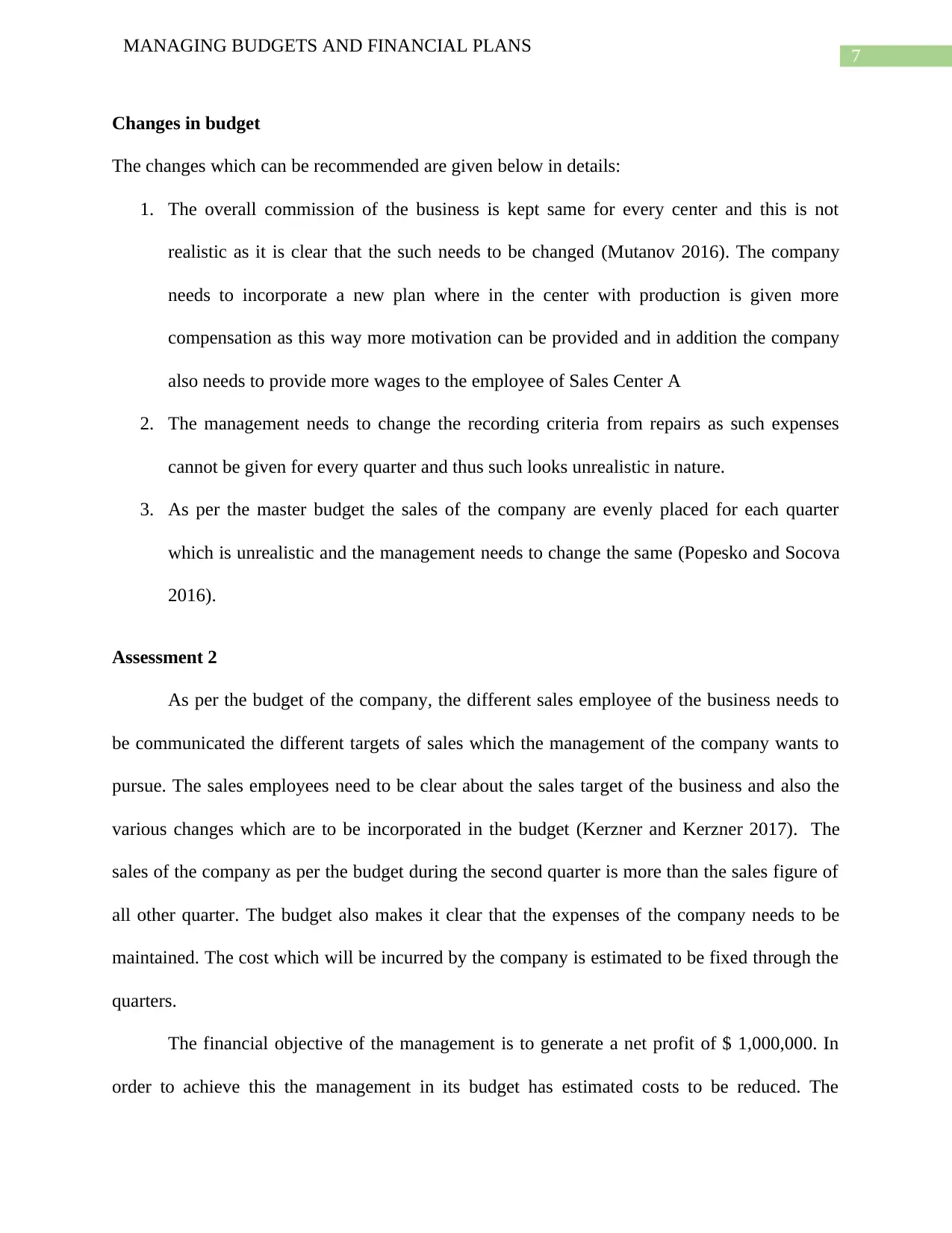
7
MANAGING BUDGETS AND FINANCIAL PLANS
Changes in budget
The changes which can be recommended are given below in details:
1. The overall commission of the business is kept same for every center and this is not
realistic as it is clear that the such needs to be changed (Mutanov 2016). The company
needs to incorporate a new plan where in the center with production is given more
compensation as this way more motivation can be provided and in addition the company
also needs to provide more wages to the employee of Sales Center A
2. The management needs to change the recording criteria from repairs as such expenses
cannot be given for every quarter and thus such looks unrealistic in nature.
3. As per the master budget the sales of the company are evenly placed for each quarter
which is unrealistic and the management needs to change the same (Popesko and Socova
2016).
Assessment 2
As per the budget of the company, the different sales employee of the business needs to
be communicated the different targets of sales which the management of the company wants to
pursue. The sales employees need to be clear about the sales target of the business and also the
various changes which are to be incorporated in the budget (Kerzner and Kerzner 2017). The
sales of the company as per the budget during the second quarter is more than the sales figure of
all other quarter. The budget also makes it clear that the expenses of the company needs to be
maintained. The cost which will be incurred by the company is estimated to be fixed through the
quarters.
The financial objective of the management is to generate a net profit of $ 1,000,000. In
order to achieve this the management in its budget has estimated costs to be reduced. The
MANAGING BUDGETS AND FINANCIAL PLANS
Changes in budget
The changes which can be recommended are given below in details:
1. The overall commission of the business is kept same for every center and this is not
realistic as it is clear that the such needs to be changed (Mutanov 2016). The company
needs to incorporate a new plan where in the center with production is given more
compensation as this way more motivation can be provided and in addition the company
also needs to provide more wages to the employee of Sales Center A
2. The management needs to change the recording criteria from repairs as such expenses
cannot be given for every quarter and thus such looks unrealistic in nature.
3. As per the master budget the sales of the company are evenly placed for each quarter
which is unrealistic and the management needs to change the same (Popesko and Socova
2016).
Assessment 2
As per the budget of the company, the different sales employee of the business needs to
be communicated the different targets of sales which the management of the company wants to
pursue. The sales employees need to be clear about the sales target of the business and also the
various changes which are to be incorporated in the budget (Kerzner and Kerzner 2017). The
sales of the company as per the budget during the second quarter is more than the sales figure of
all other quarter. The budget also makes it clear that the expenses of the company needs to be
maintained. The cost which will be incurred by the company is estimated to be fixed through the
quarters.
The financial objective of the management is to generate a net profit of $ 1,000,000. In
order to achieve this the management in its budget has estimated costs to be reduced. The
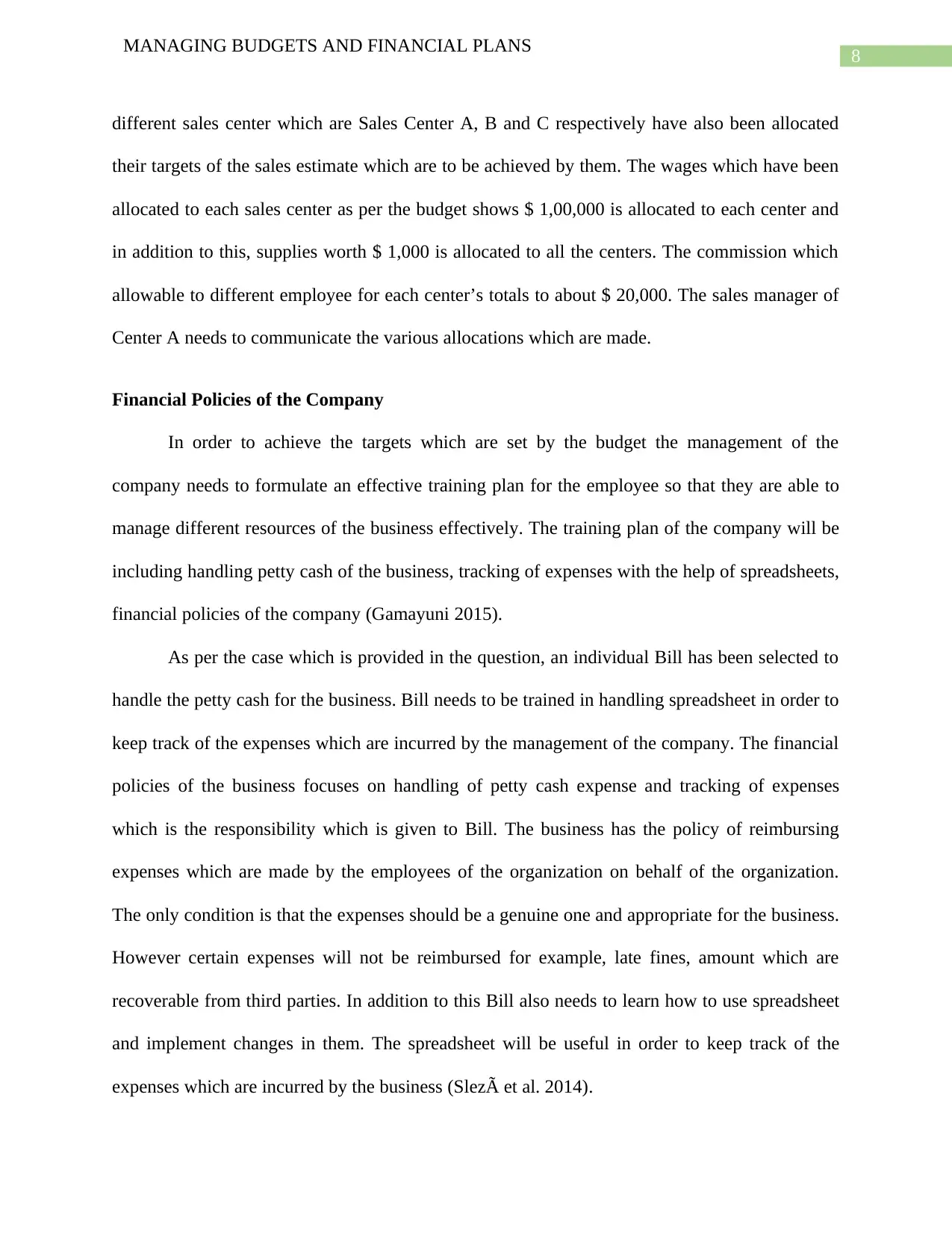
8
MANAGING BUDGETS AND FINANCIAL PLANS
different sales center which are Sales Center A, B and C respectively have also been allocated
their targets of the sales estimate which are to be achieved by them. The wages which have been
allocated to each sales center as per the budget shows $ 1,00,000 is allocated to each center and
in addition to this, supplies worth $ 1,000 is allocated to all the centers. The commission which
allowable to different employee for each center’s totals to about $ 20,000. The sales manager of
Center A needs to communicate the various allocations which are made.
Financial Policies of the Company
In order to achieve the targets which are set by the budget the management of the
company needs to formulate an effective training plan for the employee so that they are able to
manage different resources of the business effectively. The training plan of the company will be
including handling petty cash of the business, tracking of expenses with the help of spreadsheets,
financial policies of the company (Gamayuni 2015).
As per the case which is provided in the question, an individual Bill has been selected to
handle the petty cash for the business. Bill needs to be trained in handling spreadsheet in order to
keep track of the expenses which are incurred by the management of the company. The financial
policies of the business focuses on handling of petty cash expense and tracking of expenses
which is the responsibility which is given to Bill. The business has the policy of reimbursing
expenses which are made by the employees of the organization on behalf of the organization.
The only condition is that the expenses should be a genuine one and appropriate for the business.
However certain expenses will not be reimbursed for example, late fines, amount which are
recoverable from third parties. In addition to this Bill also needs to learn how to use spreadsheet
and implement changes in them. The spreadsheet will be useful in order to keep track of the
expenses which are incurred by the business (Slezà et al. 2014).
MANAGING BUDGETS AND FINANCIAL PLANS
different sales center which are Sales Center A, B and C respectively have also been allocated
their targets of the sales estimate which are to be achieved by them. The wages which have been
allocated to each sales center as per the budget shows $ 1,00,000 is allocated to each center and
in addition to this, supplies worth $ 1,000 is allocated to all the centers. The commission which
allowable to different employee for each center’s totals to about $ 20,000. The sales manager of
Center A needs to communicate the various allocations which are made.
Financial Policies of the Company
In order to achieve the targets which are set by the budget the management of the
company needs to formulate an effective training plan for the employee so that they are able to
manage different resources of the business effectively. The training plan of the company will be
including handling petty cash of the business, tracking of expenses with the help of spreadsheets,
financial policies of the company (Gamayuni 2015).
As per the case which is provided in the question, an individual Bill has been selected to
handle the petty cash for the business. Bill needs to be trained in handling spreadsheet in order to
keep track of the expenses which are incurred by the management of the company. The financial
policies of the business focuses on handling of petty cash expense and tracking of expenses
which is the responsibility which is given to Bill. The business has the policy of reimbursing
expenses which are made by the employees of the organization on behalf of the organization.
The only condition is that the expenses should be a genuine one and appropriate for the business.
However certain expenses will not be reimbursed for example, late fines, amount which are
recoverable from third parties. In addition to this Bill also needs to learn how to use spreadsheet
and implement changes in them. The spreadsheet will be useful in order to keep track of the
expenses which are incurred by the business (Slezà et al. 2014).
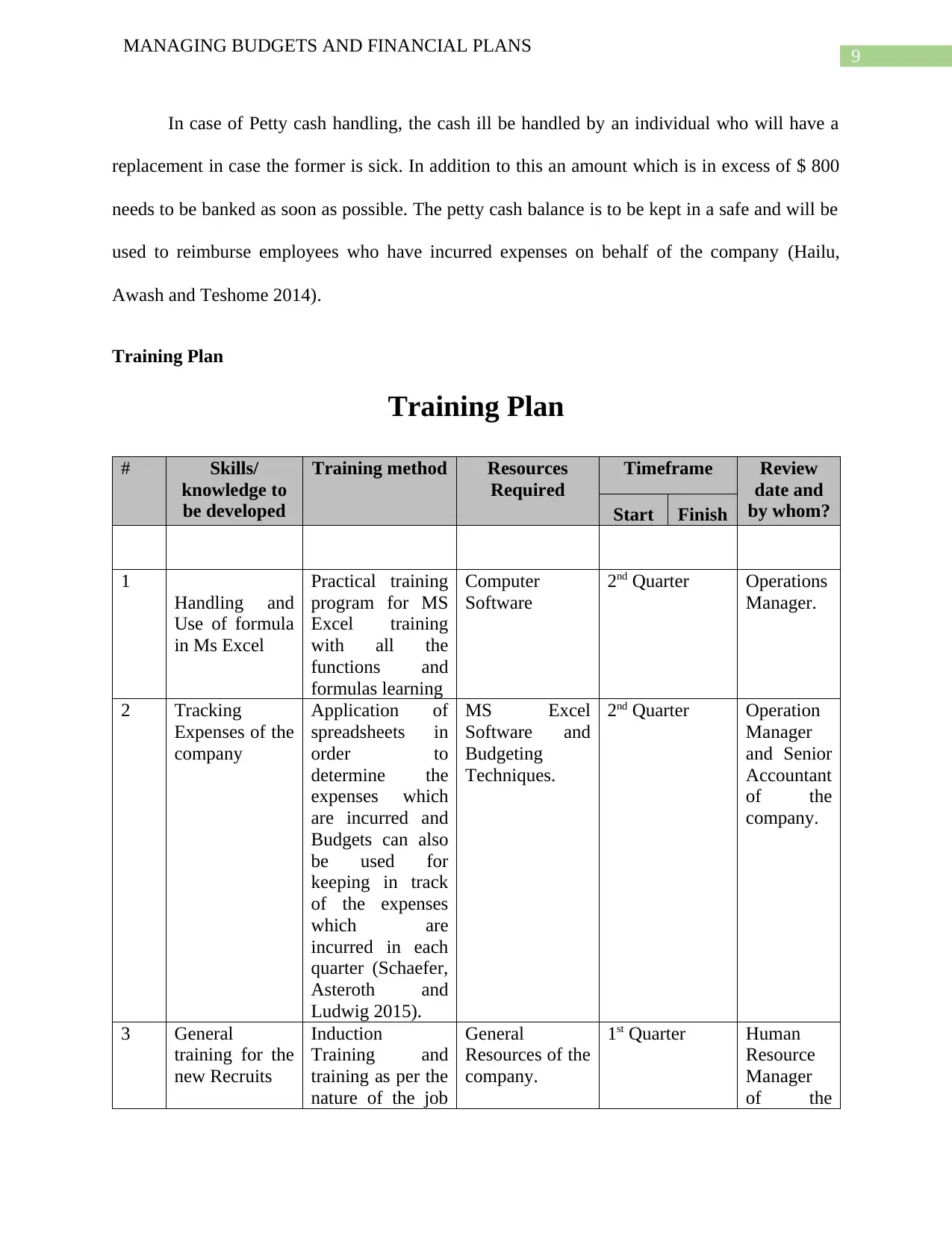
9
MANAGING BUDGETS AND FINANCIAL PLANS
In case of Petty cash handling, the cash ill be handled by an individual who will have a
replacement in case the former is sick. In addition to this an amount which is in excess of $ 800
needs to be banked as soon as possible. The petty cash balance is to be kept in a safe and will be
used to reimburse employees who have incurred expenses on behalf of the company (Hailu,
Awash and Teshome 2014).
Training Plan
Training Plan
# Skills/
knowledge to
be developed
Training method Resources
Required
Timeframe Review
date and
by whom?Start Finish
1
Handling and
Use of formula
in Ms Excel
Practical training
program for MS
Excel training
with all the
functions and
formulas learning
Computer
Software
2nd Quarter Operations
Manager.
2 Tracking
Expenses of the
company
Application of
spreadsheets in
order to
determine the
expenses which
are incurred and
Budgets can also
be used for
keeping in track
of the expenses
which are
incurred in each
quarter (Schaefer,
Asteroth and
Ludwig 2015).
MS Excel
Software and
Budgeting
Techniques.
2nd Quarter Operation
Manager
and Senior
Accountant
of the
company.
3 General
training for the
new Recruits
Induction
Training and
training as per the
nature of the job
General
Resources of the
company.
1st Quarter Human
Resource
Manager
of the
MANAGING BUDGETS AND FINANCIAL PLANS
In case of Petty cash handling, the cash ill be handled by an individual who will have a
replacement in case the former is sick. In addition to this an amount which is in excess of $ 800
needs to be banked as soon as possible. The petty cash balance is to be kept in a safe and will be
used to reimburse employees who have incurred expenses on behalf of the company (Hailu,
Awash and Teshome 2014).
Training Plan
Training Plan
# Skills/
knowledge to
be developed
Training method Resources
Required
Timeframe Review
date and
by whom?Start Finish
1
Handling and
Use of formula
in Ms Excel
Practical training
program for MS
Excel training
with all the
functions and
formulas learning
Computer
Software
2nd Quarter Operations
Manager.
2 Tracking
Expenses of the
company
Application of
spreadsheets in
order to
determine the
expenses which
are incurred and
Budgets can also
be used for
keeping in track
of the expenses
which are
incurred in each
quarter (Schaefer,
Asteroth and
Ludwig 2015).
MS Excel
Software and
Budgeting
Techniques.
2nd Quarter Operation
Manager
and Senior
Accountant
of the
company.
3 General
training for the
new Recruits
Induction
Training and
training as per the
nature of the job
General
Resources of the
company.
1st Quarter Human
Resource
Manager
of the
Secure Best Marks with AI Grader
Need help grading? Try our AI Grader for instant feedback on your assignments.
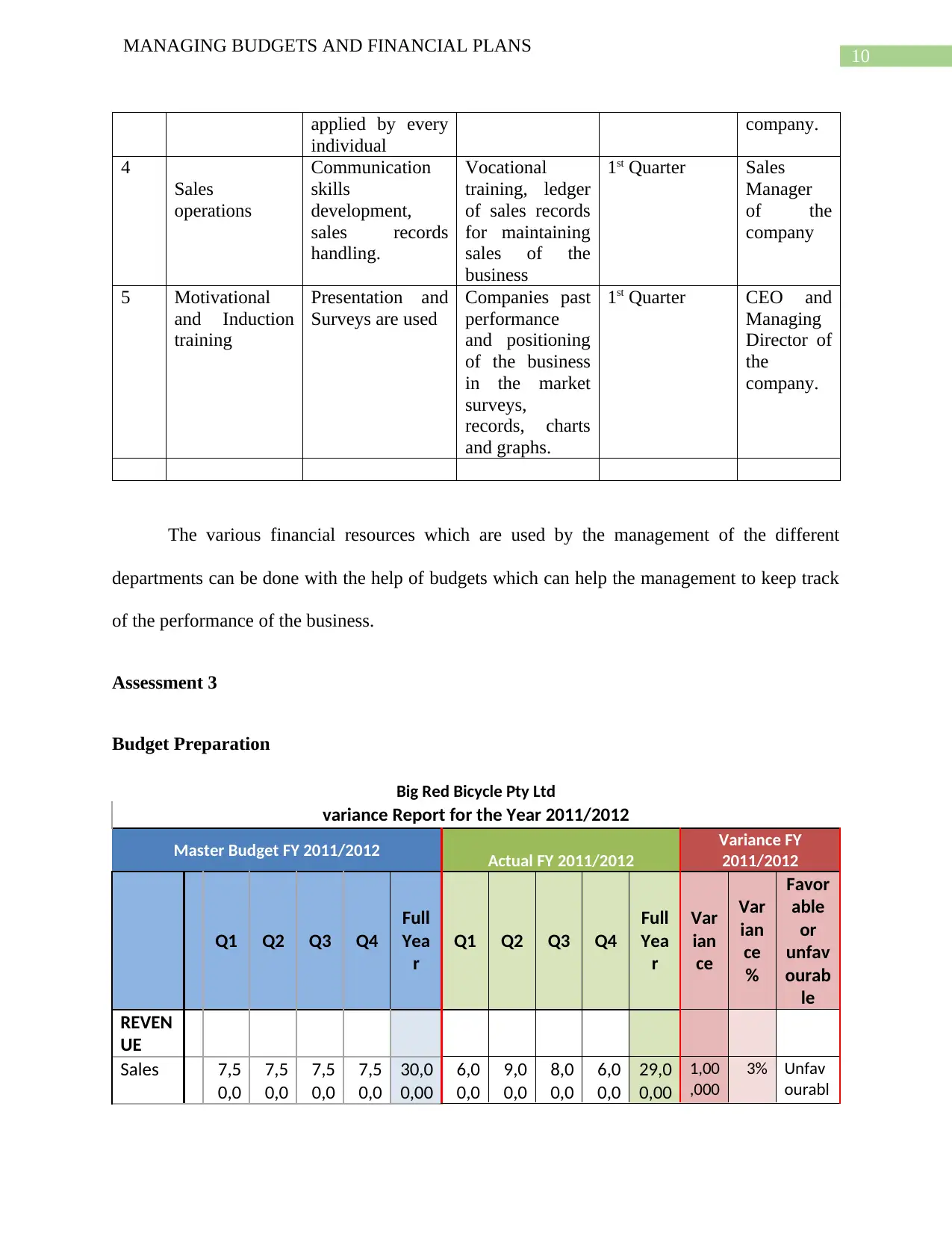
10
MANAGING BUDGETS AND FINANCIAL PLANS
applied by every
individual
company.
4
Sales
operations
Communication
skills
development,
sales records
handling.
Vocational
training, ledger
of sales records
for maintaining
sales of the
business
1st Quarter Sales
Manager
of the
company
5 Motivational
and Induction
training
Presentation and
Surveys are used
Companies past
performance
and positioning
of the business
in the market
surveys,
records, charts
and graphs.
1st Quarter CEO and
Managing
Director of
the
company.
The various financial resources which are used by the management of the different
departments can be done with the help of budgets which can help the management to keep track
of the performance of the business.
Assessment 3
Budget Preparation
Big Red Bicycle Pty Ltd
variance Report for the Year 2011/2012
Master Budget FY 2011/2012 Actual FY 2011/2012
Variance FY
2011/2012
Q1 Q2 Q3 Q4
Full
Yea
r
Q1 Q2 Q3 Q4
Full
Yea
r
Var
ian
ce
Var
ian
ce
%
Favor
able
or
unfav
ourab
le
REVEN
UE
Sales 7,5
0,0
7,5
0,0
7,5
0,0
7,5
0,0
30,0
0,00
6,0
0,0
9,0
0,0
8,0
0,0
6,0
0,0
29,0
0,00
1,00
,000
3% Unfav
ourabl
MANAGING BUDGETS AND FINANCIAL PLANS
applied by every
individual
company.
4
Sales
operations
Communication
skills
development,
sales records
handling.
Vocational
training, ledger
of sales records
for maintaining
sales of the
business
1st Quarter Sales
Manager
of the
company
5 Motivational
and Induction
training
Presentation and
Surveys are used
Companies past
performance
and positioning
of the business
in the market
surveys,
records, charts
and graphs.
1st Quarter CEO and
Managing
Director of
the
company.
The various financial resources which are used by the management of the different
departments can be done with the help of budgets which can help the management to keep track
of the performance of the business.
Assessment 3
Budget Preparation
Big Red Bicycle Pty Ltd
variance Report for the Year 2011/2012
Master Budget FY 2011/2012 Actual FY 2011/2012
Variance FY
2011/2012
Q1 Q2 Q3 Q4
Full
Yea
r
Q1 Q2 Q3 Q4
Full
Yea
r
Var
ian
ce
Var
ian
ce
%
Favor
able
or
unfav
ourab
le
REVEN
UE
Sales 7,5
0,0
7,5
0,0
7,5
0,0
7,5
0,0
30,0
0,00
6,0
0,0
9,0
0,0
8,0
0,0
6,0
0,0
29,0
0,00
1,00
,000
3% Unfav
ourabl
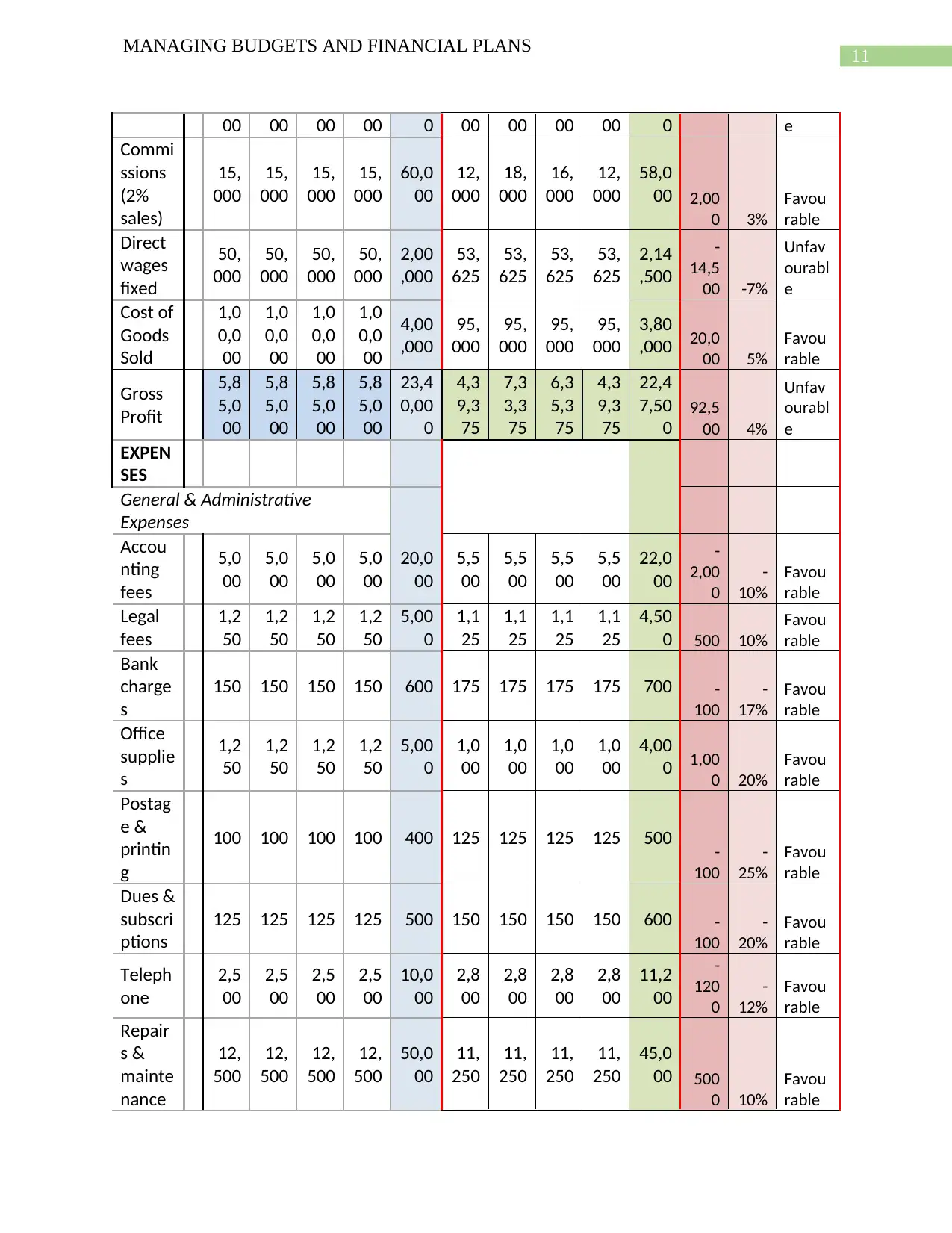
11
MANAGING BUDGETS AND FINANCIAL PLANS
00 00 00 00 0 00 00 00 00 0 e
Commi
ssions
(2%
sales)
15,
000
15,
000
15,
000
15,
000
60,0
00
12,
000
18,
000
16,
000
12,
000
58,0
00 2,00
0 3%
Favou
rable
Direct
wages
fixed
50,
000
50,
000
50,
000
50,
000
2,00
,000
53,
625
53,
625
53,
625
53,
625
2,14
,500
-
14,5
00 -7%
Unfav
ourabl
e
Cost of
Goods
Sold
1,0
0,0
00
1,0
0,0
00
1,0
0,0
00
1,0
0,0
00
4,00
,000
95,
000
95,
000
95,
000
95,
000
3,80
,000 20,0
00 5%
Favou
rable
Gross
Profit
5,8
5,0
00
5,8
5,0
00
5,8
5,0
00
5,8
5,0
00
23,4
0,00
0
4,3
9,3
75
7,3
3,3
75
6,3
5,3
75
4,3
9,3
75
22,4
7,50
0
92,5
00 4%
Unfav
ourabl
e
EXPEN
SES
General & Administrative
Expenses
Accou
nting
fees
5,0
00
5,0
00
5,0
00
5,0
00
20,0
00
5,5
00
5,5
00
5,5
00
5,5
00
22,0
00
-
2,00
0
-
10%
Favou
rable
Legal
fees
1,2
50
1,2
50
1,2
50
1,2
50
5,00
0
1,1
25
1,1
25
1,1
25
1,1
25
4,50
0 500 10%
Favou
rable
Bank
charge
s
150 150 150 150 600 175 175 175 175 700 -
100
-
17%
Favou
rable
Office
supplie
s
1,2
50
1,2
50
1,2
50
1,2
50
5,00
0
1,0
00
1,0
00
1,0
00
1,0
00
4,00
0 1,00
0 20%
Favou
rable
Postag
e &
printin
g
100 100 100 100 400 125 125 125 125 500 -
100
-
25%
Favou
rable
Dues &
subscri
ptions
125 125 125 125 500 150 150 150 150 600 -
100
-
20%
Favou
rable
Teleph
one
2,5
00
2,5
00
2,5
00
2,5
00
10,0
00
2,8
00
2,8
00
2,8
00
2,8
00
11,2
00
-
120
0
-
12%
Favou
rable
Repair
s &
mainte
nance
12,
500
12,
500
12,
500
12,
500
50,0
00
11,
250
11,
250
11,
250
11,
250
45,0
00 500
0 10%
Favou
rable
MANAGING BUDGETS AND FINANCIAL PLANS
00 00 00 00 0 00 00 00 00 0 e
Commi
ssions
(2%
sales)
15,
000
15,
000
15,
000
15,
000
60,0
00
12,
000
18,
000
16,
000
12,
000
58,0
00 2,00
0 3%
Favou
rable
Direct
wages
fixed
50,
000
50,
000
50,
000
50,
000
2,00
,000
53,
625
53,
625
53,
625
53,
625
2,14
,500
-
14,5
00 -7%
Unfav
ourabl
e
Cost of
Goods
Sold
1,0
0,0
00
1,0
0,0
00
1,0
0,0
00
1,0
0,0
00
4,00
,000
95,
000
95,
000
95,
000
95,
000
3,80
,000 20,0
00 5%
Favou
rable
Gross
Profit
5,8
5,0
00
5,8
5,0
00
5,8
5,0
00
5,8
5,0
00
23,4
0,00
0
4,3
9,3
75
7,3
3,3
75
6,3
5,3
75
4,3
9,3
75
22,4
7,50
0
92,5
00 4%
Unfav
ourabl
e
EXPEN
SES
General & Administrative
Expenses
Accou
nting
fees
5,0
00
5,0
00
5,0
00
5,0
00
20,0
00
5,5
00
5,5
00
5,5
00
5,5
00
22,0
00
-
2,00
0
-
10%
Favou
rable
Legal
fees
1,2
50
1,2
50
1,2
50
1,2
50
5,00
0
1,1
25
1,1
25
1,1
25
1,1
25
4,50
0 500 10%
Favou
rable
Bank
charge
s
150 150 150 150 600 175 175 175 175 700 -
100
-
17%
Favou
rable
Office
supplie
s
1,2
50
1,2
50
1,2
50
1,2
50
5,00
0
1,0
00
1,0
00
1,0
00
1,0
00
4,00
0 1,00
0 20%
Favou
rable
Postag
e &
printin
g
100 100 100 100 400 125 125 125 125 500 -
100
-
25%
Favou
rable
Dues &
subscri
ptions
125 125 125 125 500 150 150 150 150 600 -
100
-
20%
Favou
rable
Teleph
one
2,5
00
2,5
00
2,5
00
2,5
00
10,0
00
2,8
00
2,8
00
2,8
00
2,8
00
11,2
00
-
120
0
-
12%
Favou
rable
Repair
s &
mainte
nance
12,
500
12,
500
12,
500
12,
500
50,0
00
11,
250
11,
250
11,
250
11,
250
45,0
00 500
0 10%
Favou
rable
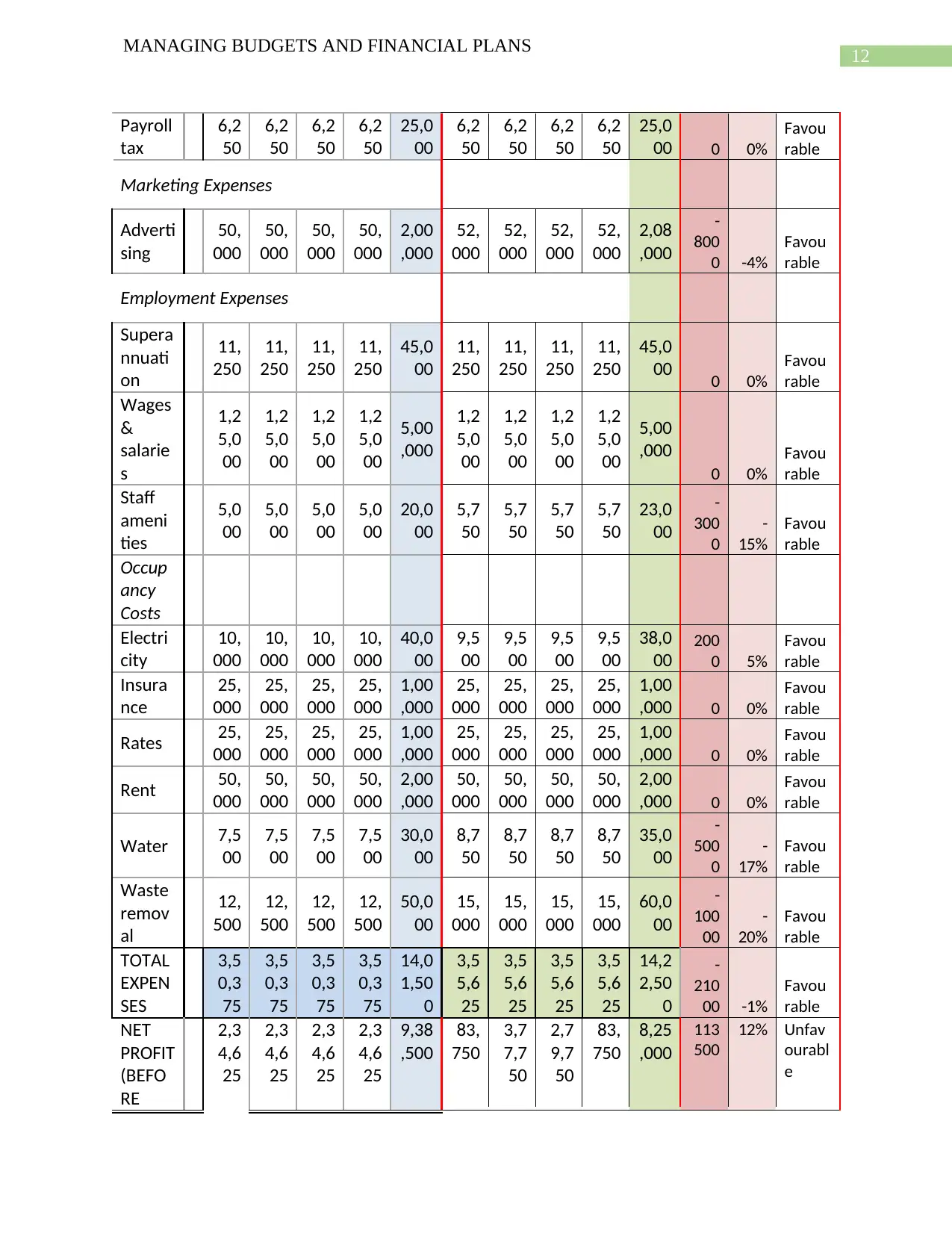
12
MANAGING BUDGETS AND FINANCIAL PLANS
Payroll
tax
6,2
50
6,2
50
6,2
50
6,2
50
25,0
00
6,2
50
6,2
50
6,2
50
6,2
50
25,0
00 0 0%
Favou
rable
Marketing Expenses
Adverti
sing
50,
000
50,
000
50,
000
50,
000
2,00
,000
52,
000
52,
000
52,
000
52,
000
2,08
,000
-
800
0 -4%
Favou
rable
Employment Expenses
Supera
nnuati
on
11,
250
11,
250
11,
250
11,
250
45,0
00
11,
250
11,
250
11,
250
11,
250
45,0
00 0 0%
Favou
rable
Wages
&
salarie
s
1,2
5,0
00
1,2
5,0
00
1,2
5,0
00
1,2
5,0
00
5,00
,000
1,2
5,0
00
1,2
5,0
00
1,2
5,0
00
1,2
5,0
00
5,00
,000
0 0%
Favou
rable
Staff
ameni
ties
5,0
00
5,0
00
5,0
00
5,0
00
20,0
00
5,7
50
5,7
50
5,7
50
5,7
50
23,0
00
-
300
0
-
15%
Favou
rable
Occup
ancy
Costs
Electri
city
10,
000
10,
000
10,
000
10,
000
40,0
00
9,5
00
9,5
00
9,5
00
9,5
00
38,0
00
200
0 5%
Favou
rable
Insura
nce
25,
000
25,
000
25,
000
25,
000
1,00
,000
25,
000
25,
000
25,
000
25,
000
1,00
,000 0 0%
Favou
rable
Rates 25,
000
25,
000
25,
000
25,
000
1,00
,000
25,
000
25,
000
25,
000
25,
000
1,00
,000 0 0%
Favou
rable
Rent 50,
000
50,
000
50,
000
50,
000
2,00
,000
50,
000
50,
000
50,
000
50,
000
2,00
,000 0 0%
Favou
rable
Water 7,5
00
7,5
00
7,5
00
7,5
00
30,0
00
8,7
50
8,7
50
8,7
50
8,7
50
35,0
00
-
500
0
-
17%
Favou
rable
Waste
remov
al
12,
500
12,
500
12,
500
12,
500
50,0
00
15,
000
15,
000
15,
000
15,
000
60,0
00
-
100
00
-
20%
Favou
rable
TOTAL
EXPEN
SES
3,5
0,3
75
3,5
0,3
75
3,5
0,3
75
3,5
0,3
75
14,0
1,50
0
3,5
5,6
25
3,5
5,6
25
3,5
5,6
25
3,5
5,6
25
14,2
2,50
0
-
210
00 -1%
Favou
rable
NET
PROFIT
(BEFO
RE
2,3
4,6
25
2,3
4,6
25
2,3
4,6
25
2,3
4,6
25
9,38
,500
83,
750
3,7
7,7
50
2,7
9,7
50
83,
750
8,25
,000
113
500
12% Unfav
ourabl
e
MANAGING BUDGETS AND FINANCIAL PLANS
Payroll
tax
6,2
50
6,2
50
6,2
50
6,2
50
25,0
00
6,2
50
6,2
50
6,2
50
6,2
50
25,0
00 0 0%
Favou
rable
Marketing Expenses
Adverti
sing
50,
000
50,
000
50,
000
50,
000
2,00
,000
52,
000
52,
000
52,
000
52,
000
2,08
,000
-
800
0 -4%
Favou
rable
Employment Expenses
Supera
nnuati
on
11,
250
11,
250
11,
250
11,
250
45,0
00
11,
250
11,
250
11,
250
11,
250
45,0
00 0 0%
Favou
rable
Wages
&
salarie
s
1,2
5,0
00
1,2
5,0
00
1,2
5,0
00
1,2
5,0
00
5,00
,000
1,2
5,0
00
1,2
5,0
00
1,2
5,0
00
1,2
5,0
00
5,00
,000
0 0%
Favou
rable
Staff
ameni
ties
5,0
00
5,0
00
5,0
00
5,0
00
20,0
00
5,7
50
5,7
50
5,7
50
5,7
50
23,0
00
-
300
0
-
15%
Favou
rable
Occup
ancy
Costs
Electri
city
10,
000
10,
000
10,
000
10,
000
40,0
00
9,5
00
9,5
00
9,5
00
9,5
00
38,0
00
200
0 5%
Favou
rable
Insura
nce
25,
000
25,
000
25,
000
25,
000
1,00
,000
25,
000
25,
000
25,
000
25,
000
1,00
,000 0 0%
Favou
rable
Rates 25,
000
25,
000
25,
000
25,
000
1,00
,000
25,
000
25,
000
25,
000
25,
000
1,00
,000 0 0%
Favou
rable
Rent 50,
000
50,
000
50,
000
50,
000
2,00
,000
50,
000
50,
000
50,
000
50,
000
2,00
,000 0 0%
Favou
rable
Water 7,5
00
7,5
00
7,5
00
7,5
00
30,0
00
8,7
50
8,7
50
8,7
50
8,7
50
35,0
00
-
500
0
-
17%
Favou
rable
Waste
remov
al
12,
500
12,
500
12,
500
12,
500
50,0
00
15,
000
15,
000
15,
000
15,
000
60,0
00
-
100
00
-
20%
Favou
rable
TOTAL
EXPEN
SES
3,5
0,3
75
3,5
0,3
75
3,5
0,3
75
3,5
0,3
75
14,0
1,50
0
3,5
5,6
25
3,5
5,6
25
3,5
5,6
25
3,5
5,6
25
14,2
2,50
0
-
210
00 -1%
Favou
rable
NET
PROFIT
(BEFO
RE
2,3
4,6
25
2,3
4,6
25
2,3
4,6
25
2,3
4,6
25
9,38
,500
83,
750
3,7
7,7
50
2,7
9,7
50
83,
750
8,25
,000
113
500
12% Unfav
ourabl
e
Paraphrase This Document
Need a fresh take? Get an instant paraphrase of this document with our AI Paraphraser
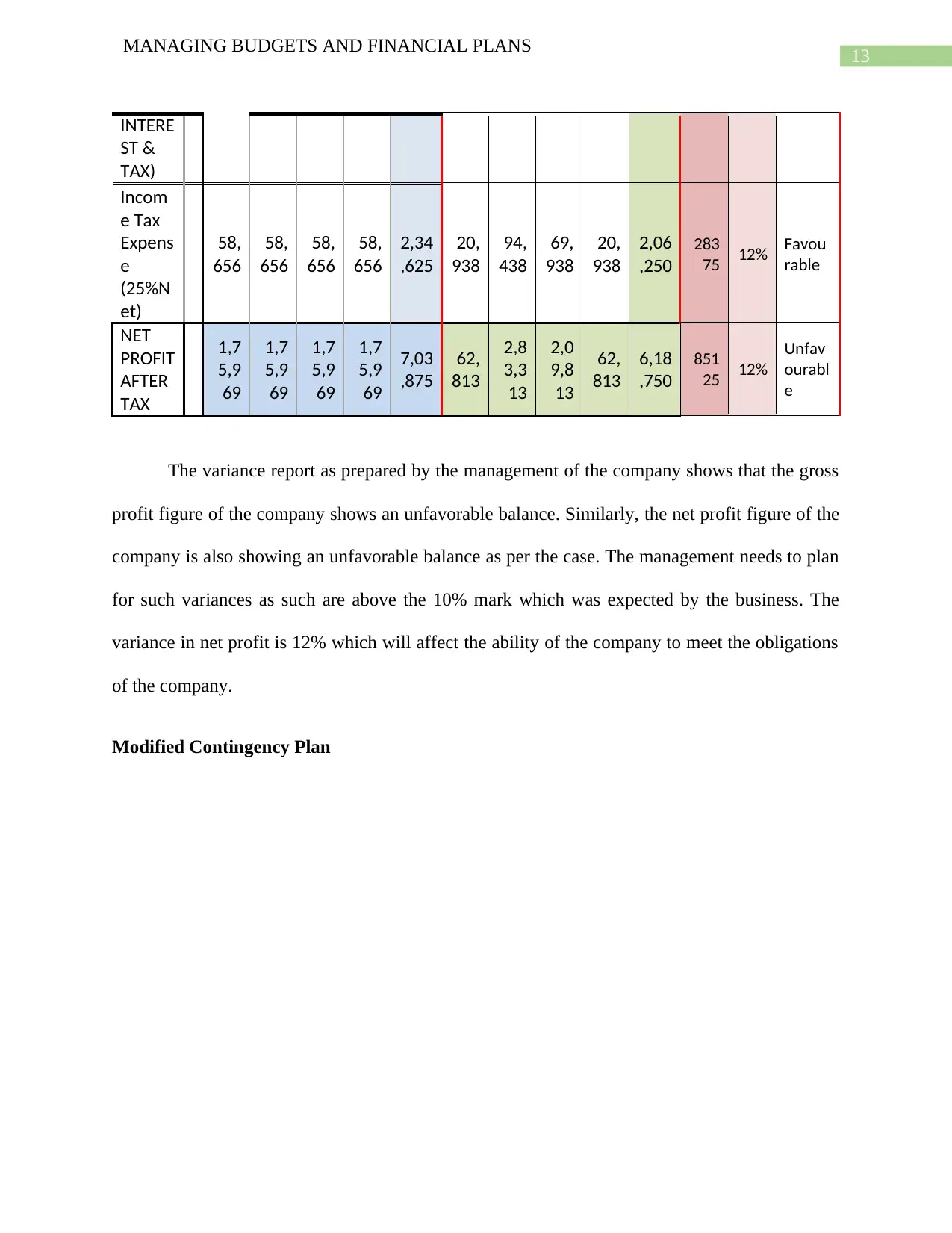
13
MANAGING BUDGETS AND FINANCIAL PLANS
INTERE
ST &
TAX)
Incom
e Tax
Expens
e
(25%N
et)
58,
656
58,
656
58,
656
58,
656
2,34
,625
20,
938
94,
438
69,
938
20,
938
2,06
,250
283
75 12% Favou
rable
NET
PROFIT
AFTER
TAX
1,7
5,9
69
1,7
5,9
69
1,7
5,9
69
1,7
5,9
69
7,03
,875
62,
813
2,8
3,3
13
2,0
9,8
13
62,
813
6,18
,750
851
25 12%
Unfav
ourabl
e
The variance report as prepared by the management of the company shows that the gross
profit figure of the company shows an unfavorable balance. Similarly, the net profit figure of the
company is also showing an unfavorable balance as per the case. The management needs to plan
for such variances as such are above the 10% mark which was expected by the business. The
variance in net profit is 12% which will affect the ability of the company to meet the obligations
of the company.
Modified Contingency Plan
MANAGING BUDGETS AND FINANCIAL PLANS
INTERE
ST &
TAX)
Incom
e Tax
Expens
e
(25%N
et)
58,
656
58,
656
58,
656
58,
656
2,34
,625
20,
938
94,
438
69,
938
20,
938
2,06
,250
283
75 12% Favou
rable
NET
PROFIT
AFTER
TAX
1,7
5,9
69
1,7
5,9
69
1,7
5,9
69
1,7
5,9
69
7,03
,875
62,
813
2,8
3,3
13
2,0
9,8
13
62,
813
6,18
,750
851
25 12%
Unfav
ourabl
e
The variance report as prepared by the management of the company shows that the gross
profit figure of the company shows an unfavorable balance. Similarly, the net profit figure of the
company is also showing an unfavorable balance as per the case. The management needs to plan
for such variances as such are above the 10% mark which was expected by the business. The
variance in net profit is 12% which will affect the ability of the company to meet the obligations
of the company.
Modified Contingency Plan
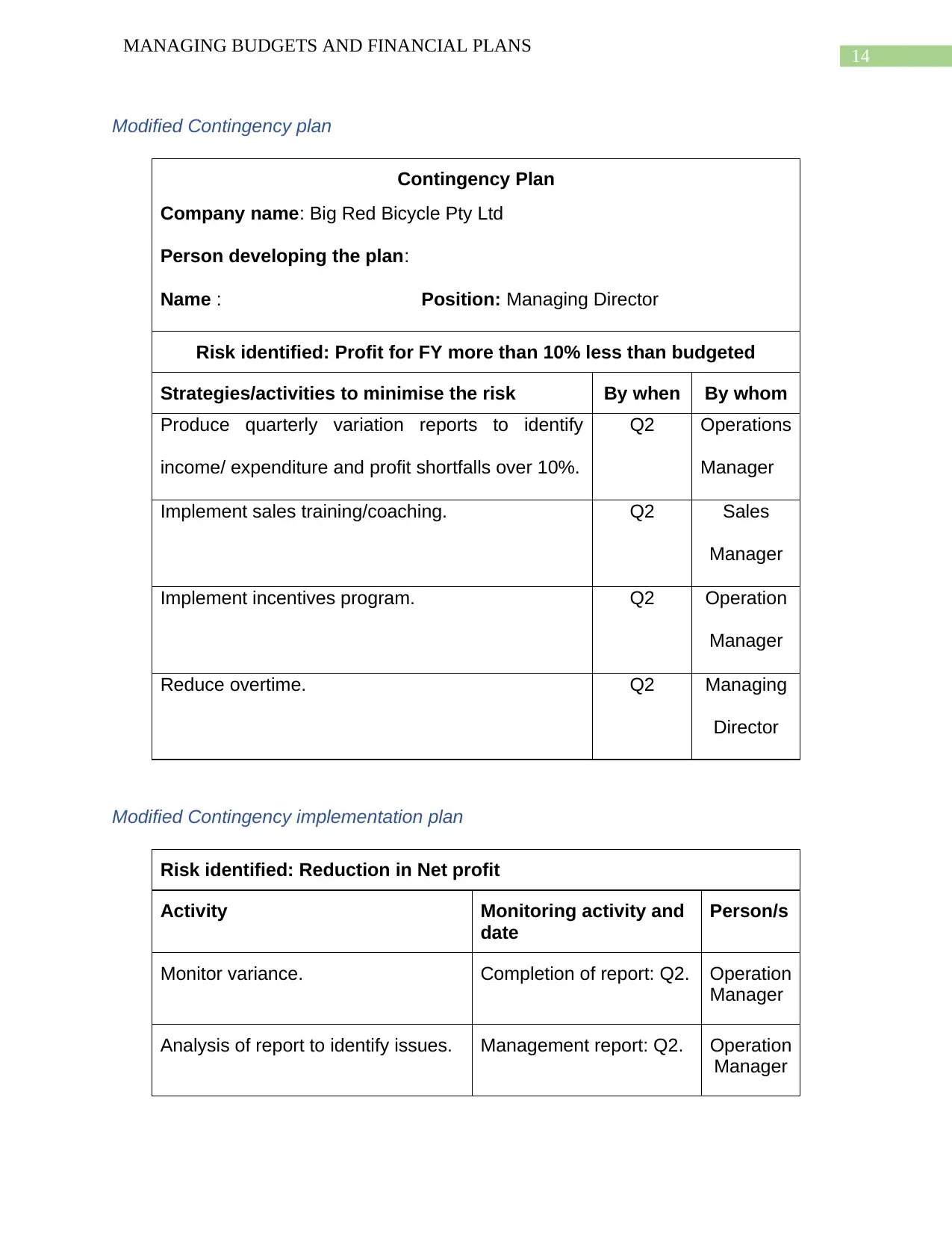
14
MANAGING BUDGETS AND FINANCIAL PLANS
Modified Contingency plan
Contingency Plan
Company name: Big Red Bicycle Pty Ltd
Person developing the plan:
Name : Position: Managing Director
Risk identified: Profit for FY more than 10% less than budgeted
Strategies/activities to minimise the risk By when By whom
Produce quarterly variation reports to identify
income/ expenditure and profit shortfalls over 10%.
Q2 Operations
Manager
Implement sales training/coaching. Q2 Sales
Manager
Implement incentives program. Q2 Operation
Manager
Reduce overtime. Q2 Managing
Director
Modified Contingency implementation plan
Risk identified: Reduction in Net profit
Activity Monitoring activity and
date
Person/s
Monitor variance. Completion of report: Q2. Operation
Manager
Analysis of report to identify issues. Management report: Q2. Operation
Manager
MANAGING BUDGETS AND FINANCIAL PLANS
Modified Contingency plan
Contingency Plan
Company name: Big Red Bicycle Pty Ltd
Person developing the plan:
Name : Position: Managing Director
Risk identified: Profit for FY more than 10% less than budgeted
Strategies/activities to minimise the risk By when By whom
Produce quarterly variation reports to identify
income/ expenditure and profit shortfalls over 10%.
Q2 Operations
Manager
Implement sales training/coaching. Q2 Sales
Manager
Implement incentives program. Q2 Operation
Manager
Reduce overtime. Q2 Managing
Director
Modified Contingency implementation plan
Risk identified: Reduction in Net profit
Activity Monitoring activity and
date
Person/s
Monitor variance. Completion of report: Q2. Operation
Manager
Analysis of report to identify issues. Management report: Q2. Operation
Manager
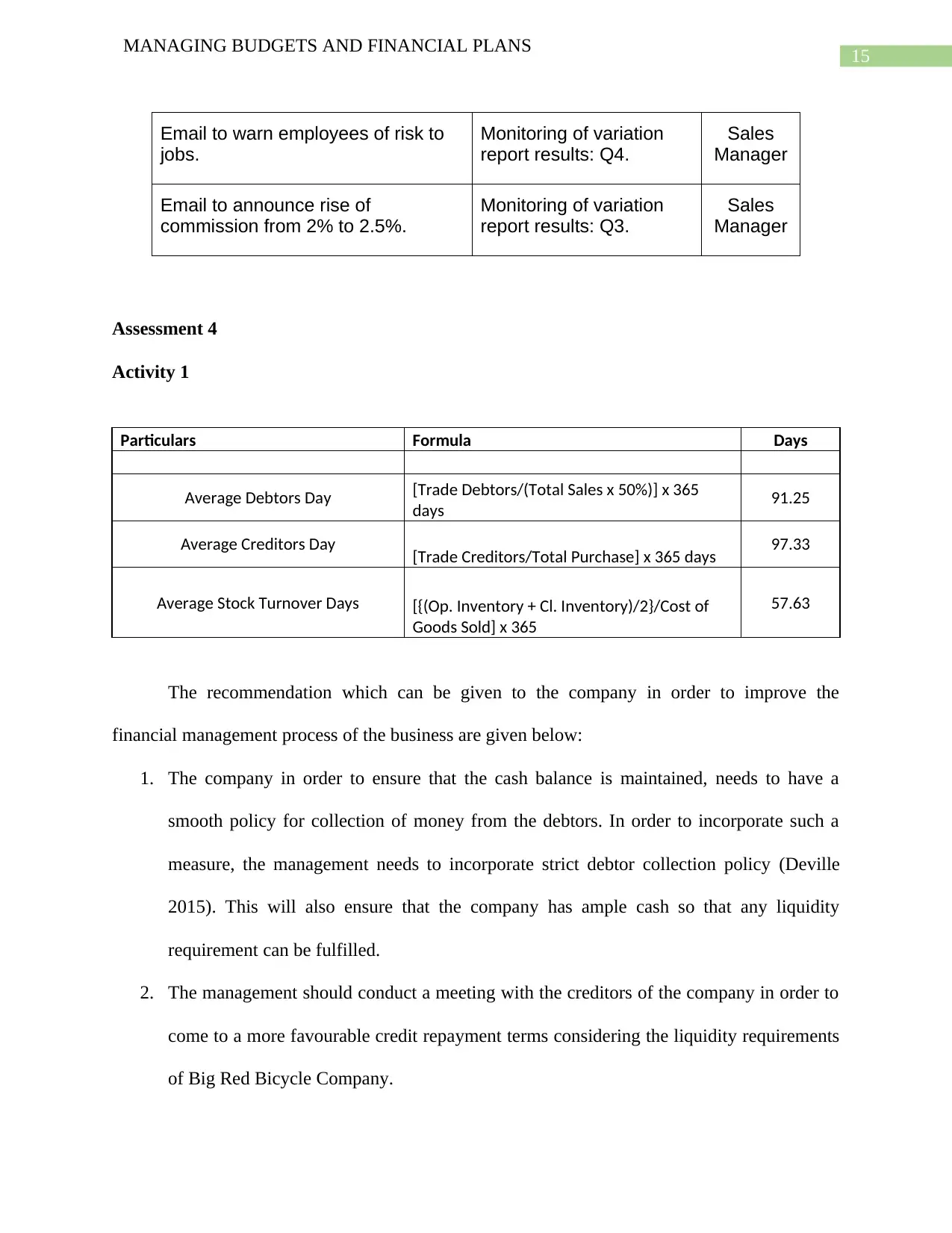
15
MANAGING BUDGETS AND FINANCIAL PLANS
Email to warn employees of risk to
jobs.
Monitoring of variation
report results: Q4.
Sales
Manager
Email to announce rise of
commission from 2% to 2.5%.
Monitoring of variation
report results: Q3.
Sales
Manager
Assessment 4
Activity 1
Particulars Formula Days
Average Debtors Day [Trade Debtors/(Total Sales x 50%)] x 365
days 91.25
Average Creditors Day [Trade Creditors/Total Purchase] x 365 days 97.33
Average Stock Turnover Days [{(Op. Inventory + Cl. Inventory)/2}/Cost of
Goods Sold] x 365
57.63
The recommendation which can be given to the company in order to improve the
financial management process of the business are given below:
1. The company in order to ensure that the cash balance is maintained, needs to have a
smooth policy for collection of money from the debtors. In order to incorporate such a
measure, the management needs to incorporate strict debtor collection policy (Deville
2015). This will also ensure that the company has ample cash so that any liquidity
requirement can be fulfilled.
2. The management should conduct a meeting with the creditors of the company in order to
come to a more favourable credit repayment terms considering the liquidity requirements
of Big Red Bicycle Company.
MANAGING BUDGETS AND FINANCIAL PLANS
Email to warn employees of risk to
jobs.
Monitoring of variation
report results: Q4.
Sales
Manager
Email to announce rise of
commission from 2% to 2.5%.
Monitoring of variation
report results: Q3.
Sales
Manager
Assessment 4
Activity 1
Particulars Formula Days
Average Debtors Day [Trade Debtors/(Total Sales x 50%)] x 365
days 91.25
Average Creditors Day [Trade Creditors/Total Purchase] x 365 days 97.33
Average Stock Turnover Days [{(Op. Inventory + Cl. Inventory)/2}/Cost of
Goods Sold] x 365
57.63
The recommendation which can be given to the company in order to improve the
financial management process of the business are given below:
1. The company in order to ensure that the cash balance is maintained, needs to have a
smooth policy for collection of money from the debtors. In order to incorporate such a
measure, the management needs to incorporate strict debtor collection policy (Deville
2015). This will also ensure that the company has ample cash so that any liquidity
requirement can be fulfilled.
2. The management should conduct a meeting with the creditors of the company in order to
come to a more favourable credit repayment terms considering the liquidity requirements
of Big Red Bicycle Company.
Secure Best Marks with AI Grader
Need help grading? Try our AI Grader for instant feedback on your assignments.
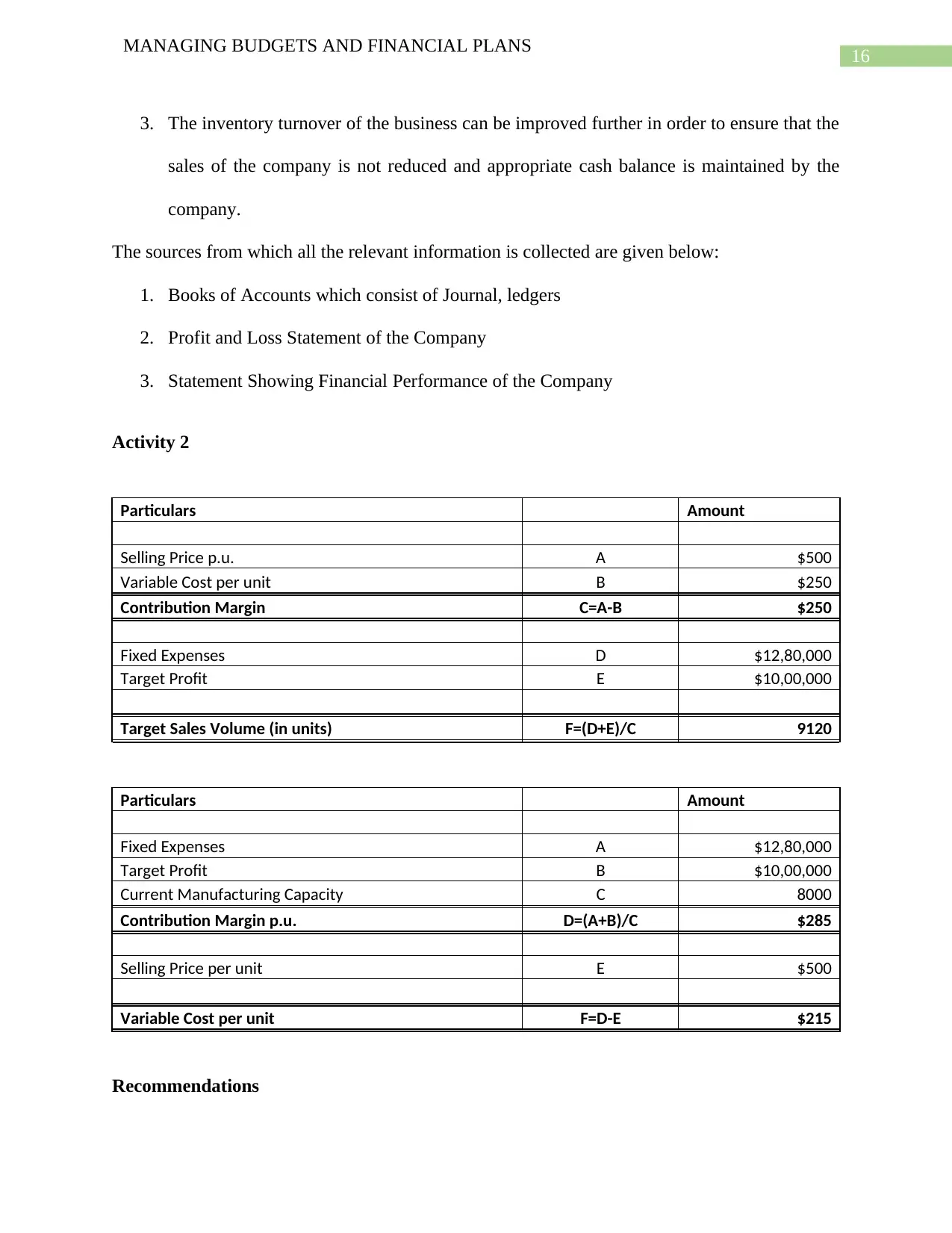
16
MANAGING BUDGETS AND FINANCIAL PLANS
3. The inventory turnover of the business can be improved further in order to ensure that the
sales of the company is not reduced and appropriate cash balance is maintained by the
company.
The sources from which all the relevant information is collected are given below:
1. Books of Accounts which consist of Journal, ledgers
2. Profit and Loss Statement of the Company
3. Statement Showing Financial Performance of the Company
Activity 2
Particulars Amount
Selling Price p.u. A $500
Variable Cost per unit B $250
Contribution Margin C=A-B $250
Fixed Expenses D $12,80,000
Target Profit E $10,00,000
Target Sales Volume (in units) F=(D+E)/C 9120
Particulars Amount
Fixed Expenses A $12,80,000
Target Profit B $10,00,000
Current Manufacturing Capacity C 8000
Contribution Margin p.u. D=(A+B)/C $285
Selling Price per unit E $500
Variable Cost per unit F=D-E $215
Recommendations
MANAGING BUDGETS AND FINANCIAL PLANS
3. The inventory turnover of the business can be improved further in order to ensure that the
sales of the company is not reduced and appropriate cash balance is maintained by the
company.
The sources from which all the relevant information is collected are given below:
1. Books of Accounts which consist of Journal, ledgers
2. Profit and Loss Statement of the Company
3. Statement Showing Financial Performance of the Company
Activity 2
Particulars Amount
Selling Price p.u. A $500
Variable Cost per unit B $250
Contribution Margin C=A-B $250
Fixed Expenses D $12,80,000
Target Profit E $10,00,000
Target Sales Volume (in units) F=(D+E)/C 9120
Particulars Amount
Fixed Expenses A $12,80,000
Target Profit B $10,00,000
Current Manufacturing Capacity C 8000
Contribution Margin p.u. D=(A+B)/C $285
Selling Price per unit E $500
Variable Cost per unit F=D-E $215
Recommendations
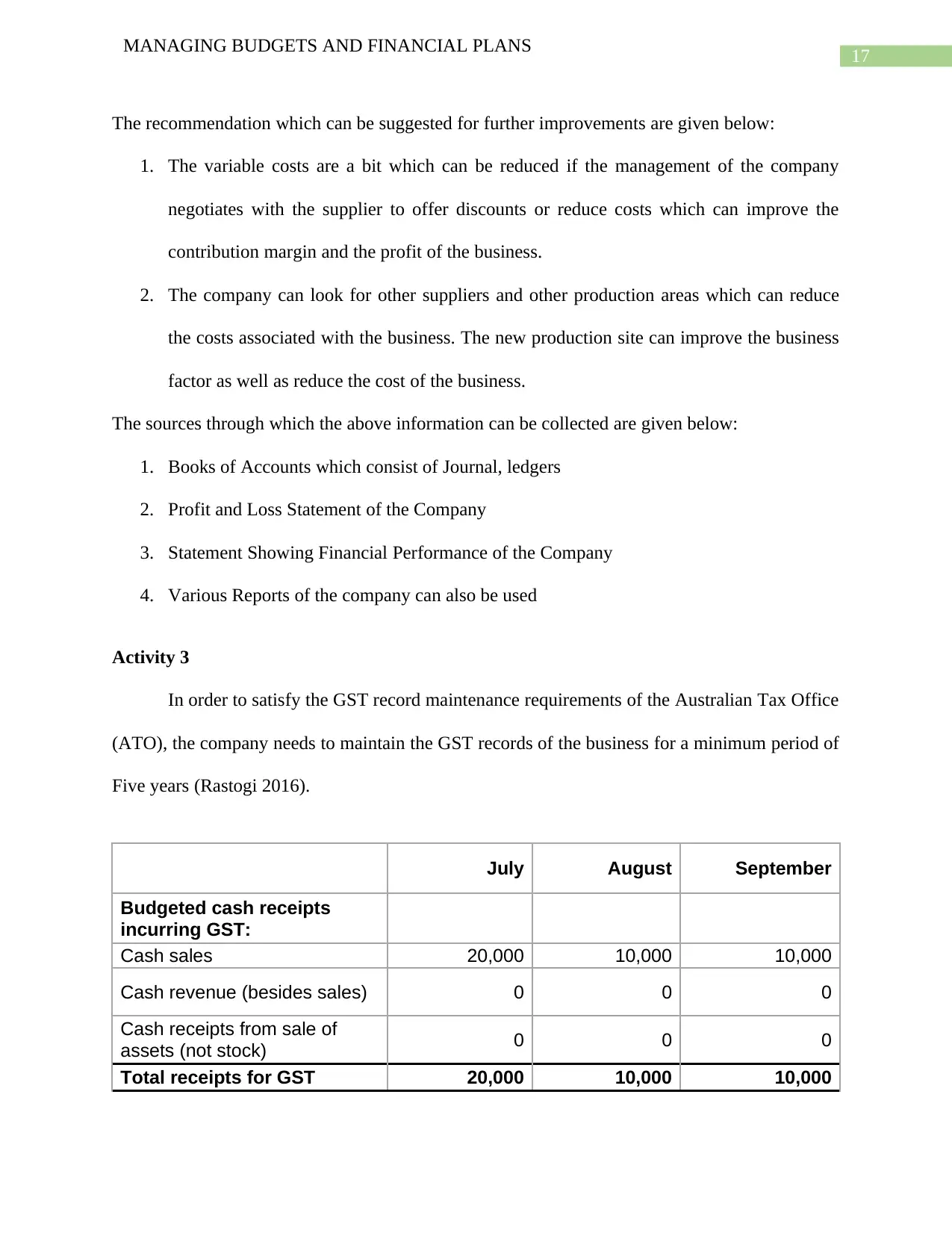
17
MANAGING BUDGETS AND FINANCIAL PLANS
The recommendation which can be suggested for further improvements are given below:
1. The variable costs are a bit which can be reduced if the management of the company
negotiates with the supplier to offer discounts or reduce costs which can improve the
contribution margin and the profit of the business.
2. The company can look for other suppliers and other production areas which can reduce
the costs associated with the business. The new production site can improve the business
factor as well as reduce the cost of the business.
The sources through which the above information can be collected are given below:
1. Books of Accounts which consist of Journal, ledgers
2. Profit and Loss Statement of the Company
3. Statement Showing Financial Performance of the Company
4. Various Reports of the company can also be used
Activity 3
In order to satisfy the GST record maintenance requirements of the Australian Tax Office
(ATO), the company needs to maintain the GST records of the business for a minimum period of
Five years (Rastogi 2016).
July August September
Budgeted cash receipts
incurring GST:
Cash sales 20,000 10,000 10,000
Cash revenue (besides sales) 0 0 0
Cash receipts from sale of
assets (not stock) 0 0 0
Total receipts for GST 20,000 10,000 10,000
MANAGING BUDGETS AND FINANCIAL PLANS
The recommendation which can be suggested for further improvements are given below:
1. The variable costs are a bit which can be reduced if the management of the company
negotiates with the supplier to offer discounts or reduce costs which can improve the
contribution margin and the profit of the business.
2. The company can look for other suppliers and other production areas which can reduce
the costs associated with the business. The new production site can improve the business
factor as well as reduce the cost of the business.
The sources through which the above information can be collected are given below:
1. Books of Accounts which consist of Journal, ledgers
2. Profit and Loss Statement of the Company
3. Statement Showing Financial Performance of the Company
4. Various Reports of the company can also be used
Activity 3
In order to satisfy the GST record maintenance requirements of the Australian Tax Office
(ATO), the company needs to maintain the GST records of the business for a minimum period of
Five years (Rastogi 2016).
July August September
Budgeted cash receipts
incurring GST:
Cash sales 20,000 10,000 10,000
Cash revenue (besides sales) 0 0 0
Cash receipts from sale of
assets (not stock) 0 0 0
Total receipts for GST 20,000 10,000 10,000
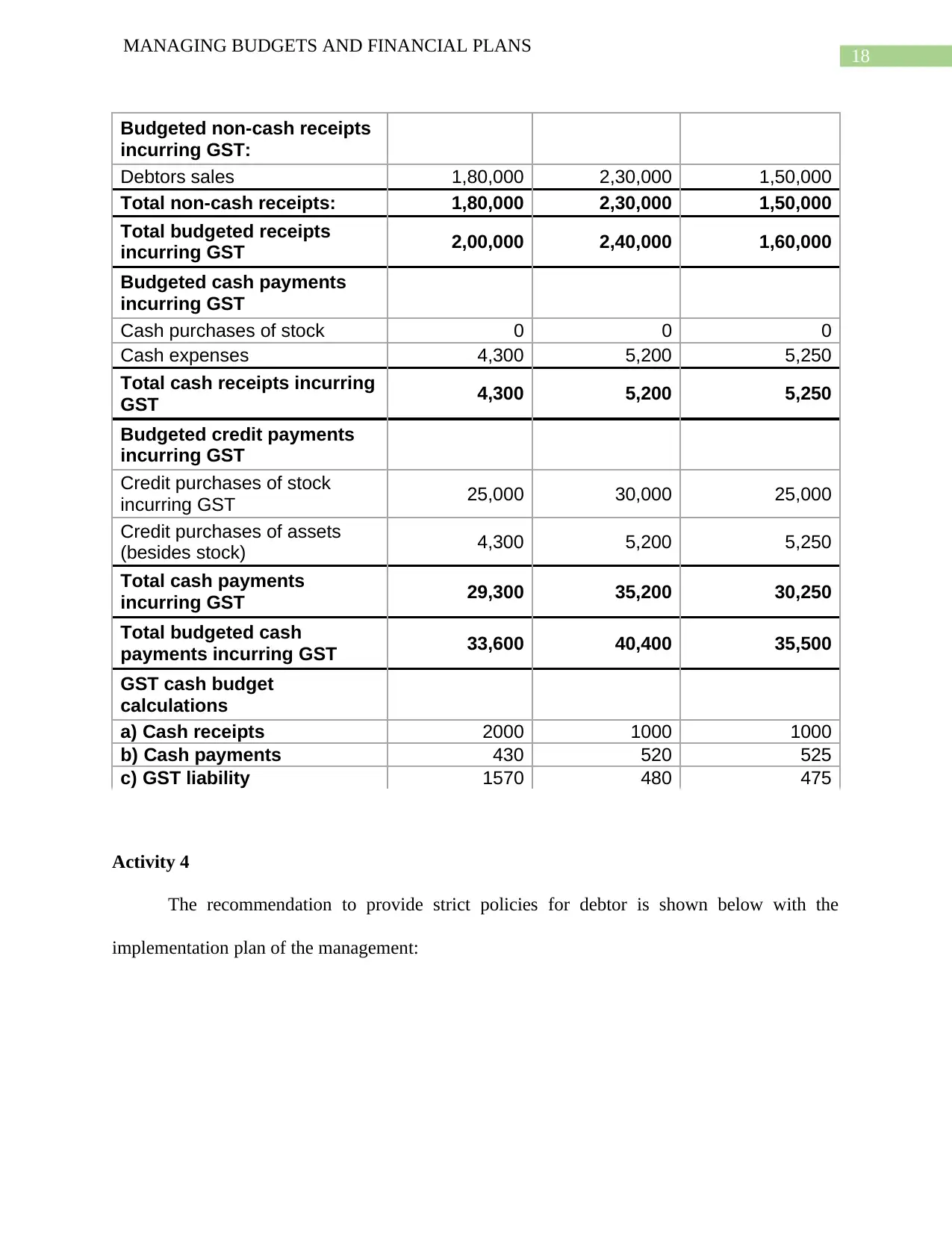
18
MANAGING BUDGETS AND FINANCIAL PLANS
Budgeted non-cash receipts
incurring GST:
Debtors sales 1,80,000 2,30,000 1,50,000
Total non-cash receipts: 1,80,000 2,30,000 1,50,000
Total budgeted receipts
incurring GST 2,00,000 2,40,000 1,60,000
Budgeted cash payments
incurring GST
Cash purchases of stock 0 0 0
Cash expenses 4,300 5,200 5,250
Total cash receipts incurring
GST 4,300 5,200 5,250
Budgeted credit payments
incurring GST
Credit purchases of stock
incurring GST 25,000 30,000 25,000
Credit purchases of assets
(besides stock) 4,300 5,200 5,250
Total cash payments
incurring GST 29,300 35,200 30,250
Total budgeted cash
payments incurring GST 33,600 40,400 35,500
GST cash budget
calculations
a) Cash receipts 2000 1000 1000
b) Cash payments 430 520 525
c) GST liability 1570 480 475
Activity 4
The recommendation to provide strict policies for debtor is shown below with the
implementation plan of the management:
MANAGING BUDGETS AND FINANCIAL PLANS
Budgeted non-cash receipts
incurring GST:
Debtors sales 1,80,000 2,30,000 1,50,000
Total non-cash receipts: 1,80,000 2,30,000 1,50,000
Total budgeted receipts
incurring GST 2,00,000 2,40,000 1,60,000
Budgeted cash payments
incurring GST
Cash purchases of stock 0 0 0
Cash expenses 4,300 5,200 5,250
Total cash receipts incurring
GST 4,300 5,200 5,250
Budgeted credit payments
incurring GST
Credit purchases of stock
incurring GST 25,000 30,000 25,000
Credit purchases of assets
(besides stock) 4,300 5,200 5,250
Total cash payments
incurring GST 29,300 35,200 30,250
Total budgeted cash
payments incurring GST 33,600 40,400 35,500
GST cash budget
calculations
a) Cash receipts 2000 1000 1000
b) Cash payments 430 520 525
c) GST liability 1570 480 475
Activity 4
The recommendation to provide strict policies for debtor is shown below with the
implementation plan of the management:
Paraphrase This Document
Need a fresh take? Get an instant paraphrase of this document with our AI Paraphraser
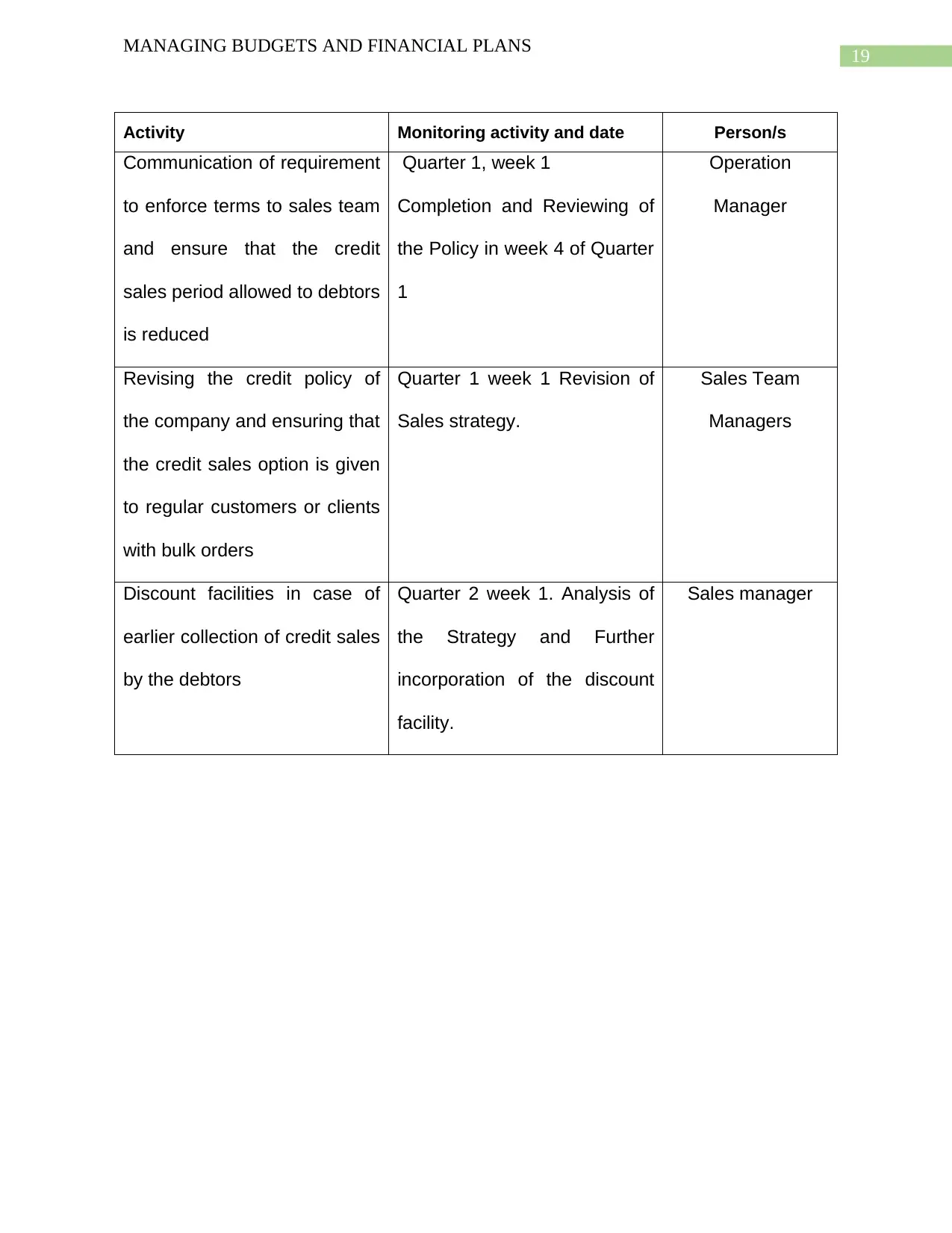
19
MANAGING BUDGETS AND FINANCIAL PLANS
Activity Monitoring activity and date Person/s
Communication of requirement
to enforce terms to sales team
and ensure that the credit
sales period allowed to debtors
is reduced
Quarter 1, week 1
Completion and Reviewing of
the Policy in week 4 of Quarter
1
Operation
Manager
Revising the credit policy of
the company and ensuring that
the credit sales option is given
to regular customers or clients
with bulk orders
Quarter 1 week 1 Revision of
Sales strategy.
Sales Team
Managers
Discount facilities in case of
earlier collection of credit sales
by the debtors
Quarter 2 week 1. Analysis of
the Strategy and Further
incorporation of the discount
facility.
Sales manager
MANAGING BUDGETS AND FINANCIAL PLANS
Activity Monitoring activity and date Person/s
Communication of requirement
to enforce terms to sales team
and ensure that the credit
sales period allowed to debtors
is reduced
Quarter 1, week 1
Completion and Reviewing of
the Policy in week 4 of Quarter
1
Operation
Manager
Revising the credit policy of
the company and ensuring that
the credit sales option is given
to regular customers or clients
with bulk orders
Quarter 1 week 1 Revision of
Sales strategy.
Sales Team
Managers
Discount facilities in case of
earlier collection of credit sales
by the debtors
Quarter 2 week 1. Analysis of
the Strategy and Further
incorporation of the discount
facility.
Sales manager
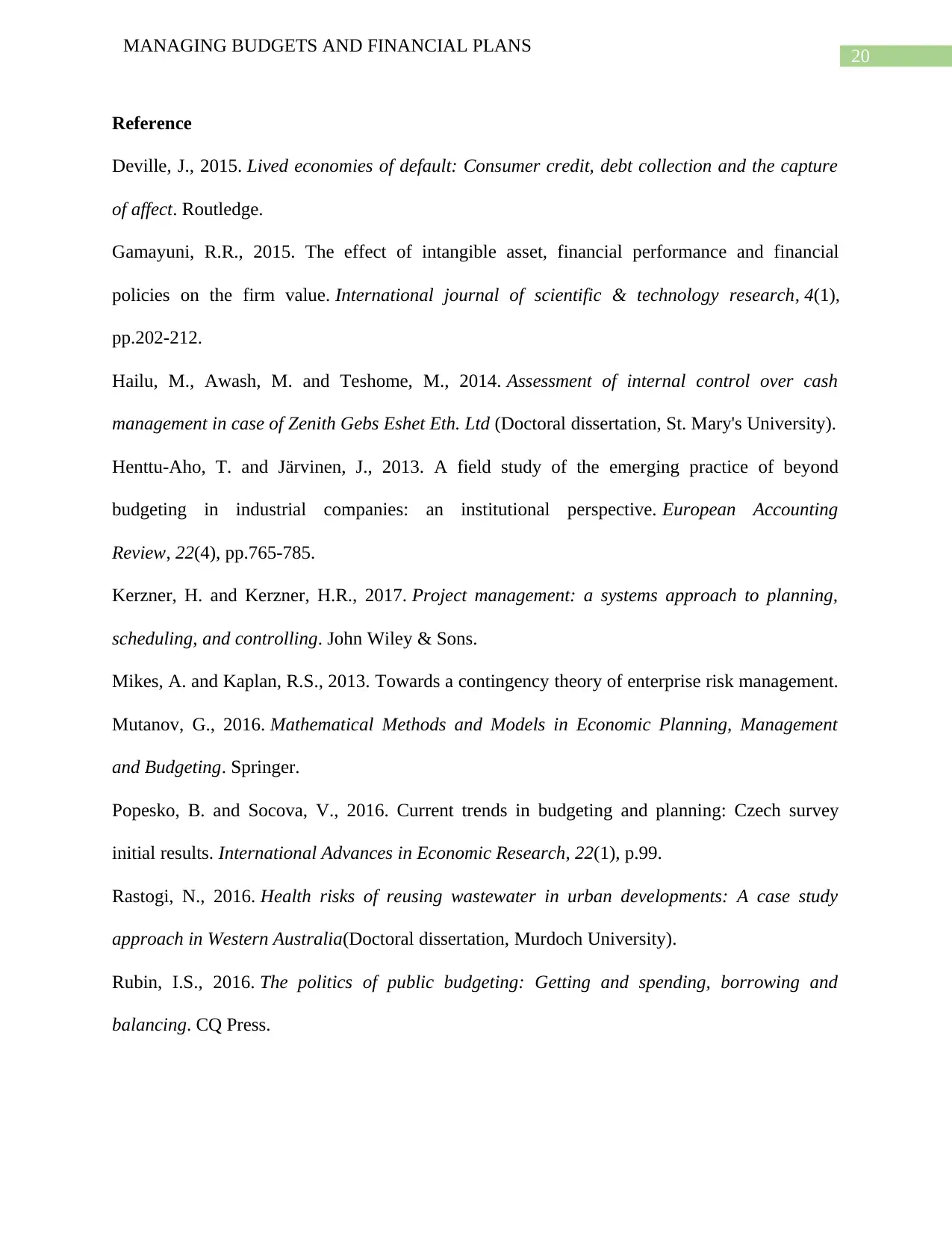
20
MANAGING BUDGETS AND FINANCIAL PLANS
Reference
Deville, J., 2015. Lived economies of default: Consumer credit, debt collection and the capture
of affect. Routledge.
Gamayuni, R.R., 2015. The effect of intangible asset, financial performance and financial
policies on the firm value. International journal of scientific & technology research, 4(1),
pp.202-212.
Hailu, M., Awash, M. and Teshome, M., 2014. Assessment of internal control over cash
management in case of Zenith Gebs Eshet Eth. Ltd (Doctoral dissertation, St. Mary's University).
Henttu-Aho, T. and Järvinen, J., 2013. A field study of the emerging practice of beyond
budgeting in industrial companies: an institutional perspective. European Accounting
Review, 22(4), pp.765-785.
Kerzner, H. and Kerzner, H.R., 2017. Project management: a systems approach to planning,
scheduling, and controlling. John Wiley & Sons.
Mikes, A. and Kaplan, R.S., 2013. Towards a contingency theory of enterprise risk management.
Mutanov, G., 2016. Mathematical Methods and Models in Economic Planning, Management
and Budgeting. Springer.
Popesko, B. and Socova, V., 2016. Current trends in budgeting and planning: Czech survey
initial results. International Advances in Economic Research, 22(1), p.99.
Rastogi, N., 2016. Health risks of reusing wastewater in urban developments: A case study
approach in Western Australia(Doctoral dissertation, Murdoch University).
Rubin, I.S., 2016. The politics of public budgeting: Getting and spending, borrowing and
balancing. CQ Press.
MANAGING BUDGETS AND FINANCIAL PLANS
Reference
Deville, J., 2015. Lived economies of default: Consumer credit, debt collection and the capture
of affect. Routledge.
Gamayuni, R.R., 2015. The effect of intangible asset, financial performance and financial
policies on the firm value. International journal of scientific & technology research, 4(1),
pp.202-212.
Hailu, M., Awash, M. and Teshome, M., 2014. Assessment of internal control over cash
management in case of Zenith Gebs Eshet Eth. Ltd (Doctoral dissertation, St. Mary's University).
Henttu-Aho, T. and Järvinen, J., 2013. A field study of the emerging practice of beyond
budgeting in industrial companies: an institutional perspective. European Accounting
Review, 22(4), pp.765-785.
Kerzner, H. and Kerzner, H.R., 2017. Project management: a systems approach to planning,
scheduling, and controlling. John Wiley & Sons.
Mikes, A. and Kaplan, R.S., 2013. Towards a contingency theory of enterprise risk management.
Mutanov, G., 2016. Mathematical Methods and Models in Economic Planning, Management
and Budgeting. Springer.
Popesko, B. and Socova, V., 2016. Current trends in budgeting and planning: Czech survey
initial results. International Advances in Economic Research, 22(1), p.99.
Rastogi, N., 2016. Health risks of reusing wastewater in urban developments: A case study
approach in Western Australia(Doctoral dissertation, Murdoch University).
Rubin, I.S., 2016. The politics of public budgeting: Getting and spending, borrowing and
balancing. CQ Press.
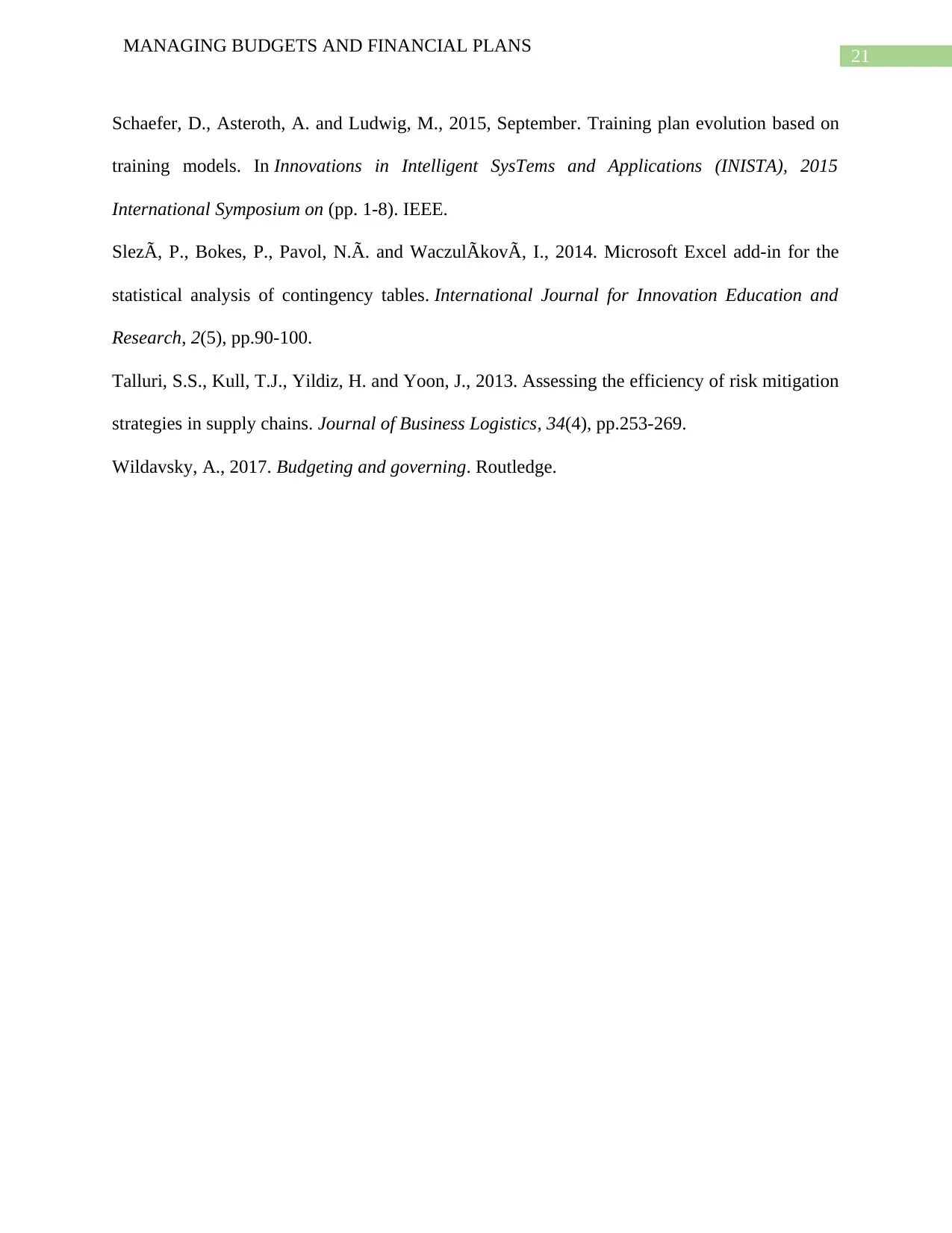
21
MANAGING BUDGETS AND FINANCIAL PLANS
Schaefer, D., Asteroth, A. and Ludwig, M., 2015, September. Training plan evolution based on
training models. In Innovations in Intelligent SysTems and Applications (INISTA), 2015
International Symposium on (pp. 1-8). IEEE.
SlezÃ, P., Bokes, P., Pavol, N.Ã. and WaczulÃkovÃ, I., 2014. Microsoft Excel add-in for the
statistical analysis of contingency tables. International Journal for Innovation Education and
Research, 2(5), pp.90-100.
Talluri, S.S., Kull, T.J., Yildiz, H. and Yoon, J., 2013. Assessing the efficiency of risk mitigation
strategies in supply chains. Journal of Business Logistics, 34(4), pp.253-269.
Wildavsky, A., 2017. Budgeting and governing. Routledge.
MANAGING BUDGETS AND FINANCIAL PLANS
Schaefer, D., Asteroth, A. and Ludwig, M., 2015, September. Training plan evolution based on
training models. In Innovations in Intelligent SysTems and Applications (INISTA), 2015
International Symposium on (pp. 1-8). IEEE.
SlezÃ, P., Bokes, P., Pavol, N.Ã. and WaczulÃkovÃ, I., 2014. Microsoft Excel add-in for the
statistical analysis of contingency tables. International Journal for Innovation Education and
Research, 2(5), pp.90-100.
Talluri, S.S., Kull, T.J., Yildiz, H. and Yoon, J., 2013. Assessing the efficiency of risk mitigation
strategies in supply chains. Journal of Business Logistics, 34(4), pp.253-269.
Wildavsky, A., 2017. Budgeting and governing. Routledge.
1 out of 22
Related Documents
Your All-in-One AI-Powered Toolkit for Academic Success.
+13062052269
info@desklib.com
Available 24*7 on WhatsApp / Email
![[object Object]](/_next/static/media/star-bottom.7253800d.svg)
Unlock your academic potential
© 2024 | Zucol Services PVT LTD | All rights reserved.





